Grandesse



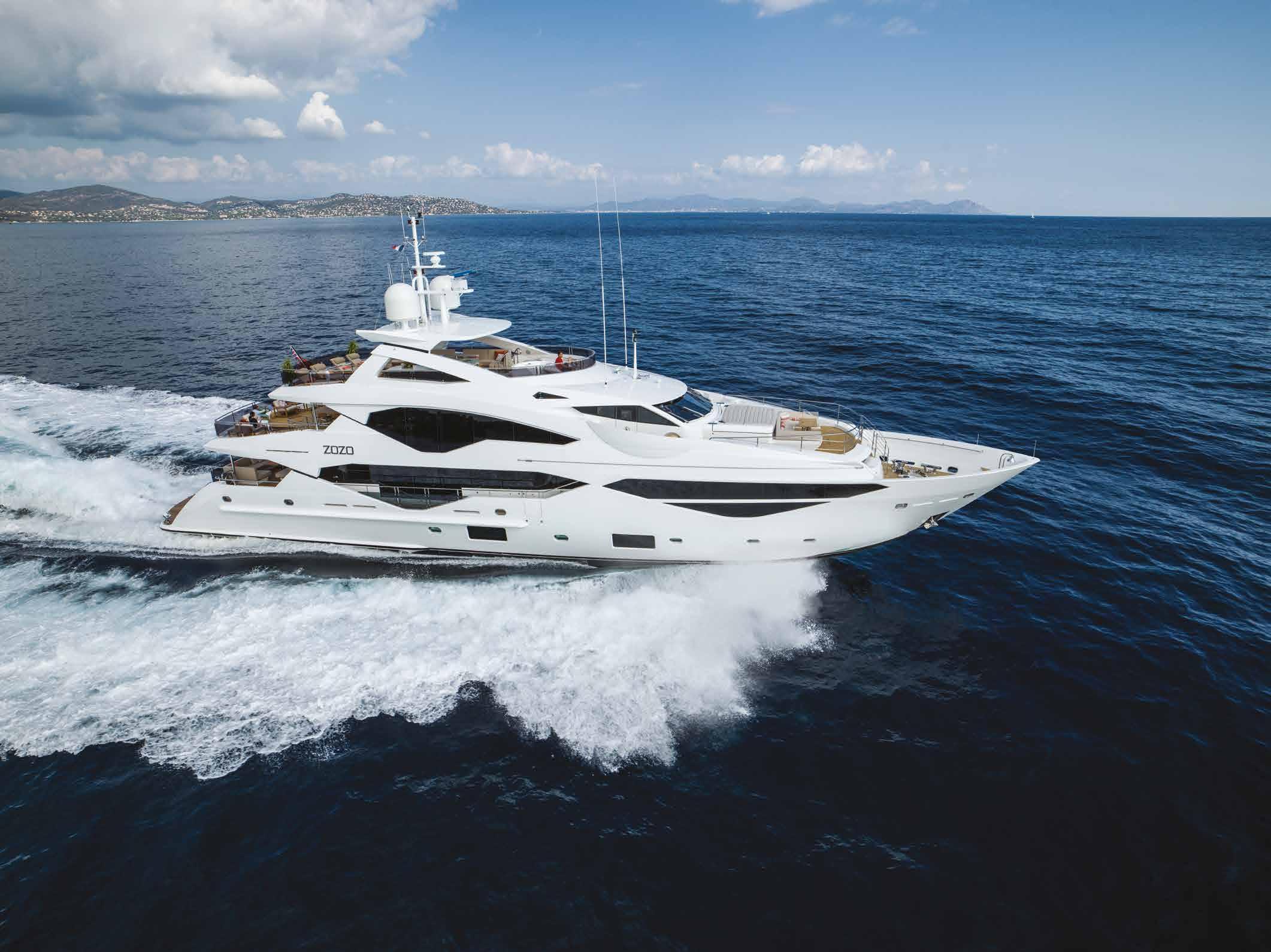












At Meridian, we are experts in crafting and delivering innovative, elegant, high performance audio visual solutions for our international customers. With over 300 industry awards and accolades to our name, we know a thing or two about authentic performance so if you’re looking for audio perfection, then look no further.



From the editor
In the realm of the arts, greatness is a wellspring of inspiration. It's a dynamic force that transcends time and culture, capable of elevating mere creations to the status of indelible masterpieces that leave an enduring mark on human history.
Welcome to Grandesse London, a name inspired by the French ode to greatness. In this and future issues, we will be exploring this wonderful phenomenon and its place in art, design, fashion, and lifestyle, as well as exploring some of the best destinations on the planet.
In this inaugural issue, we shine a light on remarkable artists who embody greatness: the lens maestro, Charlie Lightening, the street art trailblazer, Ben Eine, and the awe-inspiring Zara Muse.
Expect compelling stories, thought-provoking interviews, and captivating features, along with the latest trends in fashion, lifestyle, and travel.
In a world dominated by digital noise, we proudly embrace the tactile pleasure of print. I hope you will take a break from the digital chatter to savour articles that algorithms might never serve to your inbox.
Our team is already working on the next issue, seeking out established and new talent in the art world and beyond.
I hope you enjoy Grandesse London Magazine and it will become your go-to source for celebrating culture, artistry - and all things great.
DawnEditor-In-Chief Dawn Alford

Creative Director Marcus Leitch
Contributing editors Rob McCrossan and Ellen Millard
Motoring Editor Connor McNicolas
Feature Writer Peter Jenkinson
Editors at Large Camilla Davenport and Tracy Schaverien
Commercial Director Moh Ali
Publisher Jay Boisvert
Published by Grandesse International K O Media Ltd
156 New Cavendish St, Fitzrovia, London, W1W 6YW
For editorial opportunities contact Dawn@grandesseinternational.com
For sales and partnerships contact Moh@grandesseinternational.com
@GrandesseInt @GrandesseInt
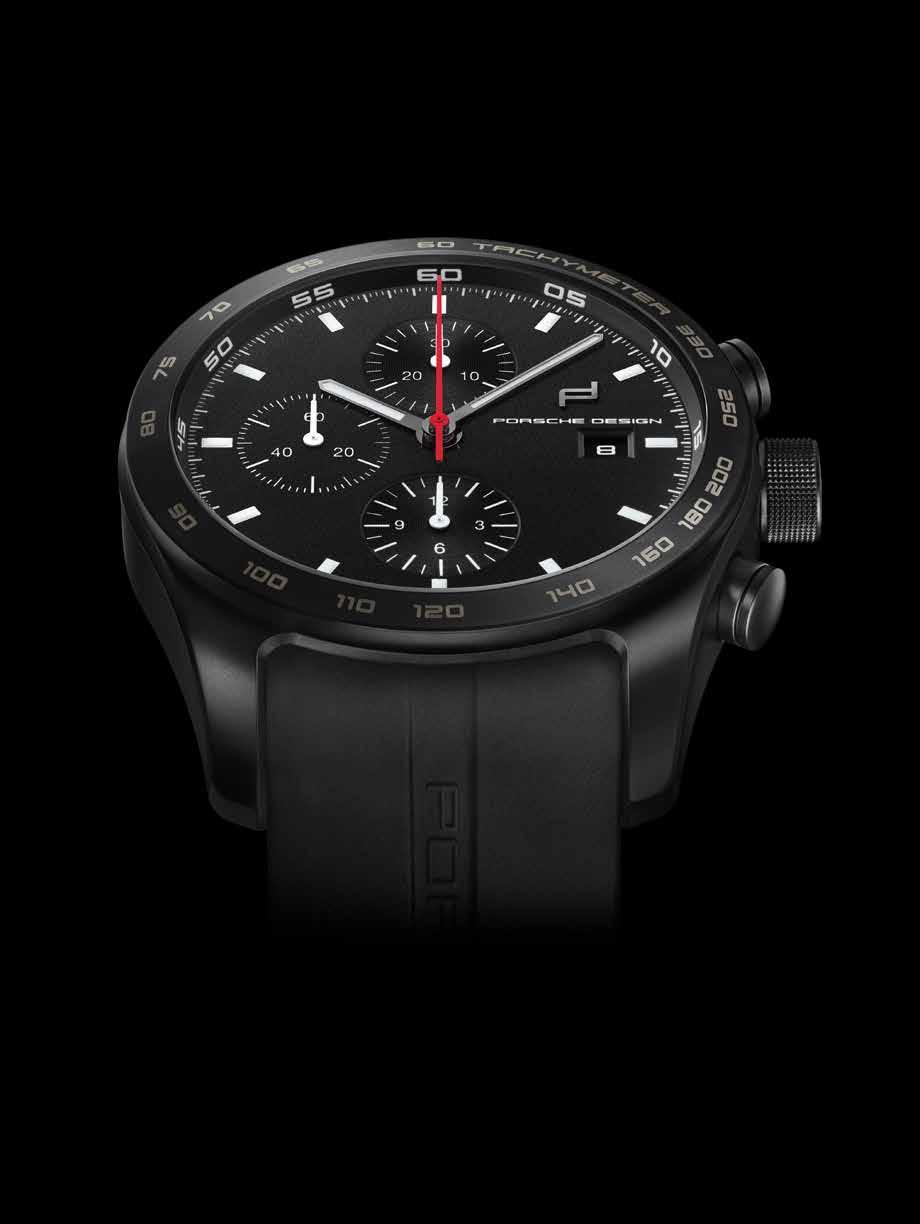
Cover Star
Spotlight on captivating artist Zara Muse
Lightening Strikes
Lensman to the stars Charlie Lightening on becoming the eyes of the music industry greats.
Streets ahead
Urban artist Ben Eime talks tags and decorating the White House

Fabulous Faberge
A tale of passion and precision

The great AI art debate Is artificial intelligence merely the latest aesthetic revolution?
Colour me happy
Diamonds with flair are now taking centre stage
Artisan style
The craftsmanship behind the worlds best fashion labels
The Eagle has landed
The Spyder caused shockwaves – and lust aplenty
Up in smoke
The most palatable pleasures revealed
A superior symposium
The Davos of the wine world, Villa D’Este on Lake Como in an oenophiles paradise
Designs on the Dorsett
Inside the West London hotel, perfect for a luxury staycation
Caribbean Queen Culture, history and warms seas beckon in Canouan - dubbed the new Mustique
Vive le livre
Tour France with a literary lens

FOR THE MORE DISCERNING LEISURE SEEKER Crafted for the demands of a country sporting life, yet a perfect match for the most urban of pursuits. Exquisitely detailed, hand-stitched, waxed hide, and eighty years of unswerving experience permeating the weather-proofed cotton drill. Rugged and refined in equal measure. ETTINGER TO EACH THEIR OWN
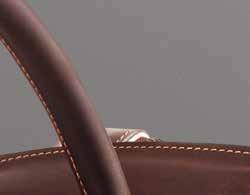
ETTINGER.CO.UK






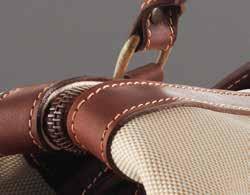
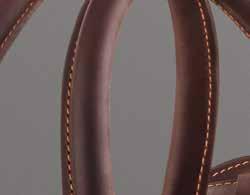
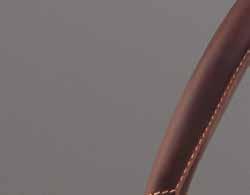




Radiant Resilience: Zara Muse's Women in Palette Knife is an aweinspiring collection that beautifully explores the transformative power of art in the face of adversity, while capturing the essence of the feminine spirit in all its glory.
Zara Muse, the brilliant artist behind these captivating works, employs palette knife techniques to infuse her subjects with life, utilizing a dynamic range of mediums that include acrylics, oils, watercolours, and mixed media.
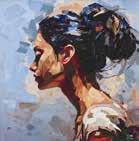
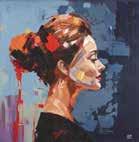


Under the pseudonym Zara Muse, Alexandra Johnson has masterfully developed a unique and impressive technique, employing both palette knives and spatulas to create her masterpieces. This method grants her artwork an incredible sense of texture and depth, resulting in paintings that possess a distinctive three-dimensional quality.
Alexandra's journey as an artist began while she enjoyed a successful career in finance, yet her heart had always been drawn to the world of art. Even during her early days as a trader in the bustling City of London, she found herself captivated by the burgeoning graffiti art scene, admiring the raw expression and creativity that adorned the city streets. This fascination with art only grew stronger as she began collecting early pieces by now-renowned artists like Banksy, Ben Eine, and Sara Pope.
Her evolution as a painter began with the creation of vibrant and expressive graffiti-style pieces, reflecting the influence of the urban art scene that had enamoured her. But she didn't stop there. Alexandra's insatiable curiosity and artistic flair led her to explore various genres, ranging from abstract and contemporary art to classical portraiture and landscapes. Embracing versatility as her guiding principle, she fearlessly experimented with acrylics, oils, watercolours, and mixed media, with each piece serving as a testament to her ability to adapt and evolve.
DAWN ALFORD


The VINTAGE AÉRONAVALE chronograph is a time measuring instrument that marries functionality and elegance. The blue and gold colours, evoking the uniform worn by naval officers, make the VINTAGE AÉRONAVALE an exceptional timepiece.


: www.bellross.com





Ahead of an exhibition focused on life on the road with Liam Gallagher, director and photographer Charlie Lightening discusses filming Sir Paul McCartney playing the piano, flying in private jets with Jamiroquai and helping Louis Tomlinson share his side of the story
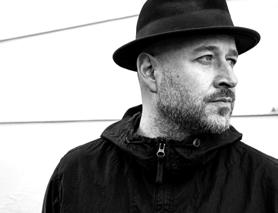
 By Ellen Millard
By Ellen Millard
In 2006, filmmaker and photographer Charlie Lightening was commissioned to create a documentary about Robbie Williams, shooting behind-the-scenes footage ahead of a concert in Leeds. In the process of making the film, Williams opened up to Lightening about his history with drug abuse and the struggles he was experiencing at the height of fame. These intimate conversations were raw and real, showing a side to the artist the public had never seen before. However, this being the Noughties, when such displays of vulnerability were typically concealed rather than publicised, the promotional piece instead aimed
to show Williams at his very best – and so these private conversations remained just so. Fast forward 17 years, and Lightening is eagerly awaiting the release of a four-part Netflix series focused on Williams’ life, in which much of his archive footage will feature.
The impending publication of this more candid story not only speaks volumes about changing attitudes towards mental health and how society perceives celebrities, but how Lightening’s approach to filmmaking was vastly ahead of the curve. A oneman-band with a cheery disposition and a camera in tow, Lightening’s personable take has helped

If I like an artist and I feel that I want them to win and succeed, I can make the audience feel that too
him carve a niche in the entertainment industry. “The films I make are very real; they’re about my relationship with a person,” he explains. “I know if I like an artist and I feel that I want them to win and succeed, I can make the audience feel that too.”
Born in Manchester in the 1980s, Lightening’s love of “big, epic movies” such as Star Wars, Indiana Jones and Back to the Future ignited in him a passion for filmmaking. Heavily influenced by his dad, a documentary cameraman, Lightening began his career shooting behind-the-scenes content for bands such as Westlife, creating short clips for special extras on CD-roms and DVDs. “It was really the beginning of content,” he explains, attributing his career trajectory to the leaps and bounds of technology. “I always thought that I needed to be a big director and have people making coffee for me to be taken seriously, but the introduction of affordable cameras, mobile phones and social media meant that you could just shadow an artist and not have to have a big team.”

Though today he flits between shooting solo and working with larger groups – he’s currently directing a feature film themed around the Canadian sitcom Trailer Park Boys – what he loves most is going on tour with a musician or band and capturing their experiences. In many cases, Lightening is the sole videographer and photographer in the team, allowing him to share a closer look at life on the road.
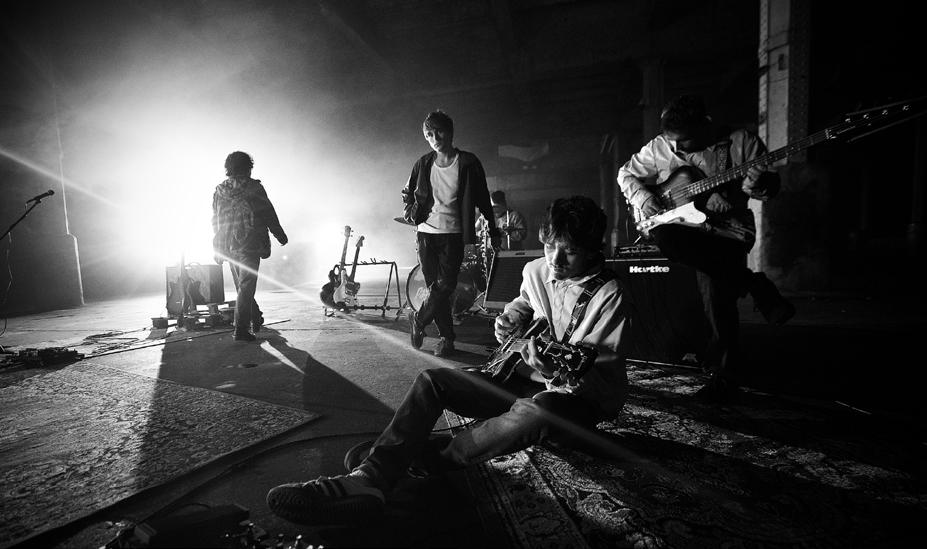
I feel very lucky to be able to stand on those stages and tell their stories
As his career has progressed, his subjects have become increasingly more famous, but his approach to shooting them has remained firmly the same.


From capturing Kasabian’s inaugural tour in Japan (“The closest I ever felt to being in a band”) to hitting the road with Jamiroquai (“He was the first person to take me around the world on private jets and yachts”), his creative process has rarely changed.
Take Sir Paul McCartney, for whom Lightening has worked for 15 years and counting. “Everywhere Paul goes and plays, it’s a real event,” he says. “I love that freedom of being just me and a camera, running around being able to film whatever I want
– whether that’s standing behind him while he’s playing Let it Be on the piano, or being in the rafters filming families holding each other and enjoying the music.”
Oftentimes Lightening is there to witness not just the sell-out shows but the trying times of writing an album, the battle with unwanted media attention and the personal struggles behind the scenes. Having worked with Liam Gallagher when he was the frontman of Beady Eye and since as a solo artist, Lightening has an archive of footage spanning more than 10 years, which charts the singer’s career since the heady heights of Oasis fame.
We all look up to these artists, but they’re just normal people, and they go through love and loss
In 2019, Liam Gallagher: As it Was was released, a documentary shot by Lightening that shared the artist’s journey to solo stardom. “Those initial small shows were amazing, the energy of it – I knew I was capturing something really special,” he says of Gallagher’s early solo gigs. “There was something really interesting happening, and I was lucky to be in the right place at the right time. The story played out and I happened to be there capturing it all.”


The success of the documentary – it won an NME award for Best Music Film in 2020 –sparked a shift in Lightening’s career, and he was approached by One Direction’s Louis Tomlinson, initially to create a series of music videos. The singer had taken time out for personal reasons (he lost his mother in 2016, and his sister in 2018), and was starting to plan his first global tour as a solo artist with trepidation. He called on Lightening to capture the experience, and the resulting footage became All of Those Voices, a documentary released in cinemas in March 2023 that touches not just on Tomlinson’s solo career but his more personal battles too. “If someone has a story to tell that’s really sensitive, I feel as a filmmaker that you have
a real responsibility to that person,” Lightening says. “We all look up to these artists, but they’re just normal people, and they go through love and loss. I knew that Louis’ story had to be in the film, because it humanises him, but it’s still on my shoulders to actually tell that story, and I felt such a responsibility.”
It’s this empathy and compassion that has given the director access to sides of artists that others have never been able to reach, and why, when Gallagher was set to perform two sold-out gigs at Knebworth in 2022, it was Lightening who he called upon to capture the career highlight, this time as a photographer. The results are to form the basis of an exhibition at Grove Gallery in 2024 (watch this space), for which the director will select his favourite moments from his years touring with the artist. “Although I count myself as more of a filmmaker than a photographer, I always take pictures along the way, and I have this huge archive – it’s unbelievable to look back at,” he says. “It will be great to be able to show Liam’s career since leaving Oasis, from live gigs to more intimate shots of him in the studio.”
While he is excited at the prospect of seeing his work displayed on the gallery walls, Lightening admits he’s far more comfortable shining the spotlight on others than being under it himself. “I feel blessed to be able to do this, but at the same time it’s a funny thing championing my own work, because I’d be nothing without the artists who I get to work with,” he says. “They’re the stars of the show, and I feel very lucky to be able to stand on those stages and tell their stories.”



If someone has a story to tell that’s really sensitive, I feel that you have a real responsibility to that person
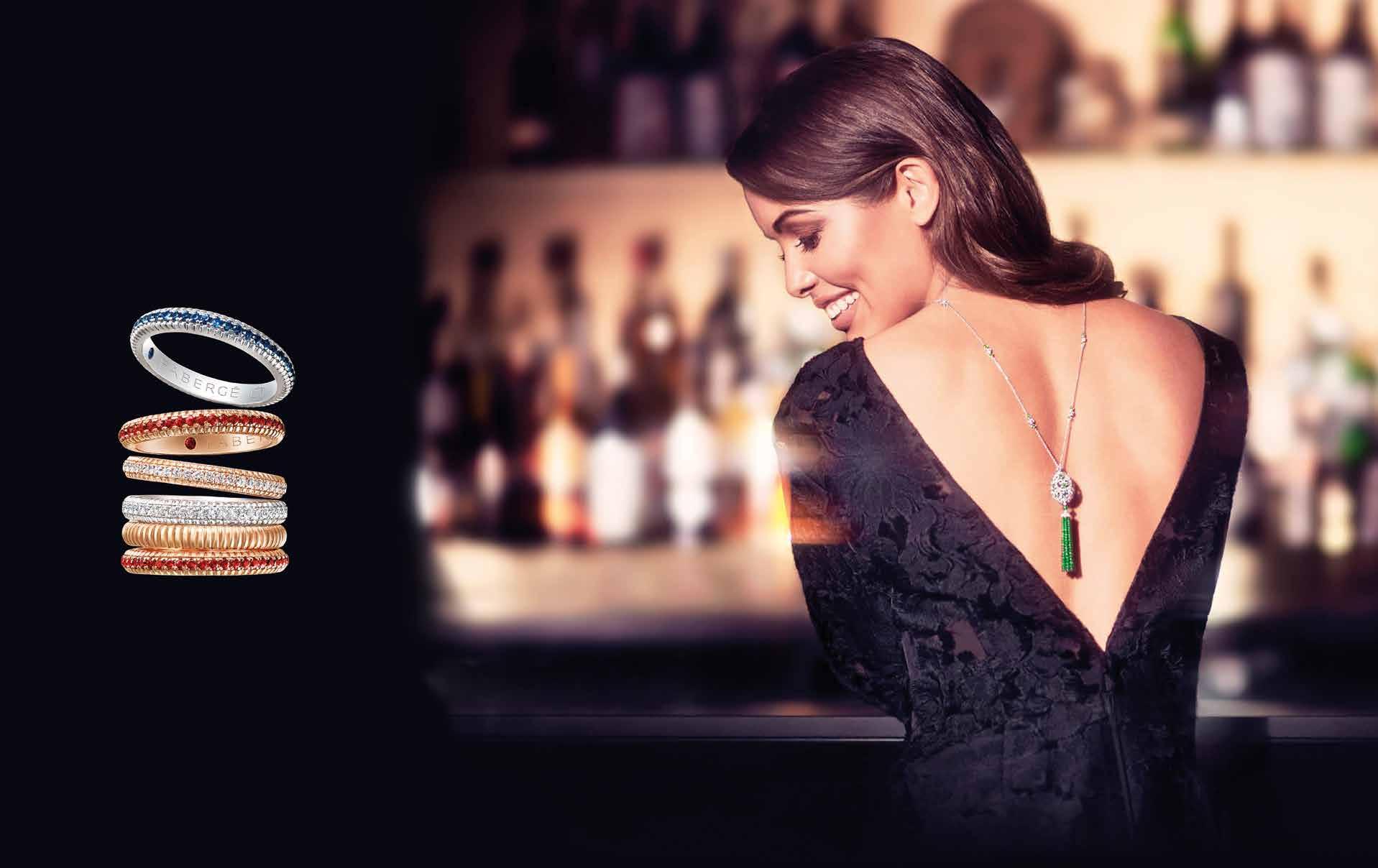


Celebrated street artist Ben Eine shares his creative journey – from tagging trains to decorating the White House – as he prepares to host an exhibition at Quantus Gallery in collaboration with graffitist Oker
By Ellen MillardOnce upon a time, you’d have found Ben Eine running around with a spray can, leaving his tag on walls, tunnels and trains, and “generally being a vandal”. He was forever fleeing from the law, often unsuccessfully, and though he made a name for himself in the graffiti world, it came at a cost. Today, while his medium of choice remains the same, his approach is far more considered and, indeed, welcomed by those who witness it. One of the world’s foremost letterform artists, whose signature rainbow typography brightens streets globally – from London to Los Angeles – Eine is often celebrated as being one of two pioneers of the street art movement as we know it today. The other? His friend Banksy.
Eine’s fascination with typography was discovered in the pages of a stolen copy of Subway Art, a coffee table book by Martha Cooper and Henry Chalfant that spotlighted the graffiti scene in New York. “It completely blew my mind. It became my bible,” he says. “I studied it, drew the graffiti outlines, knew everybody’s names and learnt the graffiti lingo, and I decided that one day I wanted to do paintings that were similar to the ones in that book.”
He took to the streets, perfecting his skills with a spray can to create letterforms that made his name stand out in the graffiti scene in more ways than one. Over the course of 20 years, he was arrested several times, paid his fair share of fines, and did the maximum amount of community service you’re allowed to do before going to prison. His wake up call came when two friends he’d been painting with were incarcerated, and he knew he would be next. Eine decided to begin making what would later be defined as street art, though at the time no such term existed.
“I started painting random letters of the alphabet on the shutters of empty, derelict shops in Brick Lane, Shoreditch, Old Street and Broadway Market. It was a weird time, because over the course of about three months, 60 of these shop shutters were painted and nobody knew who was doing it or why,” he says. Though he was still painting illegally, he found his creations were receiving a more positive reaction, and that his work was appreciated. “I found it all quite fascinating. I was interested in the fact I was doing something very similar to graffiti – spray painting big panels very quickly – but it was a lot more friendly and appealing.” He began painting in broad daylight, and found he’d reached a new audience; everyone from young families to elderly couples would approach
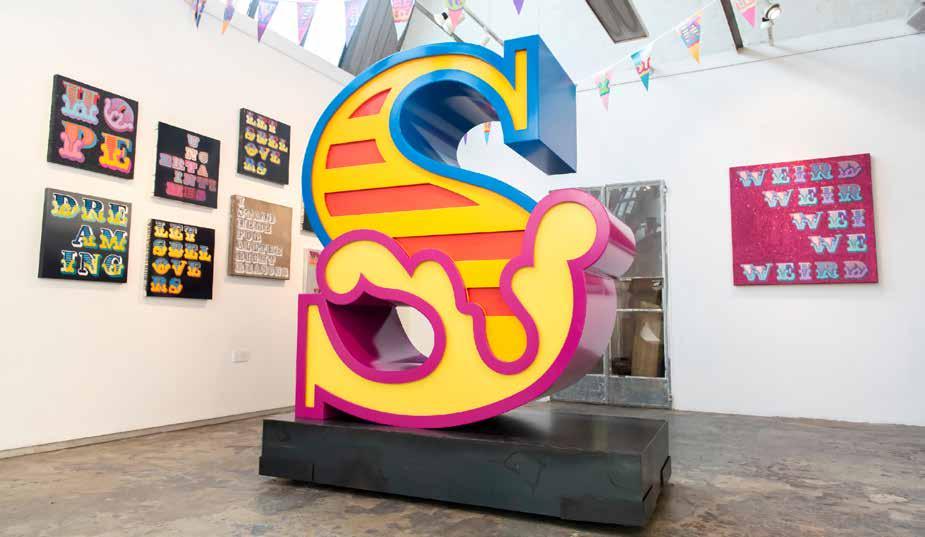
I felt like I was actually contributing to something, rather than just scribbling my tag and destroying things. That was a nice feeling
him and compliment his work. “I felt like I was actually contributing to something, rather than just scribbling my tag and destroying things,” he says. “That was a nice feeling.”
This to Eine is the distinction between graffiti and street art today. Whereas the former typically focuses on self-gratification, involving an individual’s tag painted in hard-to-reach places, and often at the risk of life and freedom, street art is about improving a space for those around it. It “adds something to the environment. It brightens up a blank wall”.
Street art also has the potential to progress into a career, largely thanks to Eine’s early contributions to the art form. In 2003, following a chance meeting at a pub near Old Street, Eine co-founded Pictures on
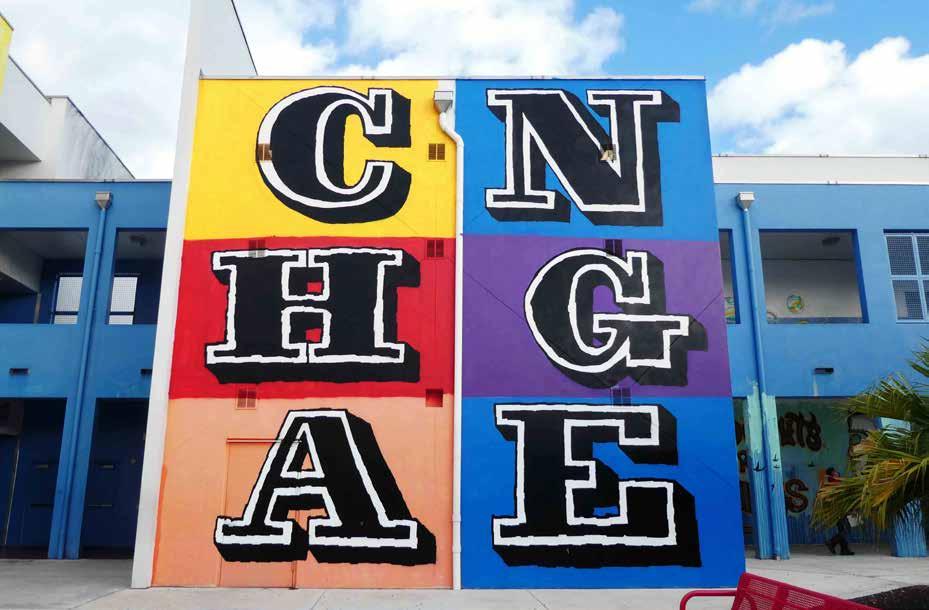
Walls gallery with the then up-and-coming Banksy and together they “invented street art”, throwing the spotlight on a new generation of creatives. Fast forward 20 years and today much street art is highly prized, meaning those who wake up to find an unexpected mural on their building may be more inclined to keep it than paint over it. “If you paint something on a wall without permission, you get arrested for criminal damage,” the artist muses. “But if you paint something on a wall without permission, and that wall is now worth £100,000, there’s an argument that you’ve actually added value.”
That hasn’t prevented people from destroying the majority of his works – he estimates that around 20 to 30 still survive – but he remains nonplussed.
I like the fact that when you pick a word, people conjure up their own meanings and feelings from it
Inspired by his travels, he’s constantly looking for new spots to showcase his unique style. Though his creative process is fluid, a new project typically begins with a location that has meaning to him. The words and phrases themselves arrive organically; they might be inspired by the neighbourhood, the people who live there or societal changes in the area, or they might be influenced by Eine’s mood and outlook at the time. “Generally, I like to leave something positive and thought provoking,” he says. “I like the fact that when you pick a word, people conjure up their own meanings and feelings from it.”
Ironically in some cases his chosen phrases have been almost too nuanced; when 10 Downing Street approached the artist in 2010 about gifting one of his artworks to President Barack Obama on behalf of David Cameron, the prime minister’s team had a task finding a slogan that wouldn’t be perceived as either too negative or too excitable. They settled on ‘Twenty First Century City’, a piece Eine let them have for free, knowingly aware of the media attention such a moment would receive. “Normally the press talk about what the wives are wearing, but I knew Samantha Cameron was pregnant and wouldn’t be flying to Washington,” Eine laughs.
I want to be sitting in that cell saying it was worth it

“When the story broke, all they talked about was the vandal that’s now in the White House.”
Despite being pleased with the accolade, Eine notes his career highlight is instead simply being “in a happy place”, working in his studio and with complete creative freedom. His latest venture is the perfect example; from 16th November 2023, he’ll be staging an exhibition at Quantus Gallery in partnership with his long-term friend and fellow graffiti alumni Oker. The duo began working together spontaneously, creating a collection of works that span paintings to sculpture and glass, and were pleased to find a gallery that was willing to give them carte blanche on an exhibition. “It’s two 50-year-old men who have known each other since they were teenagers, painting together,” Eine jokes when asked to describe the art, but he hints that the show will be a new direction for Quantus.
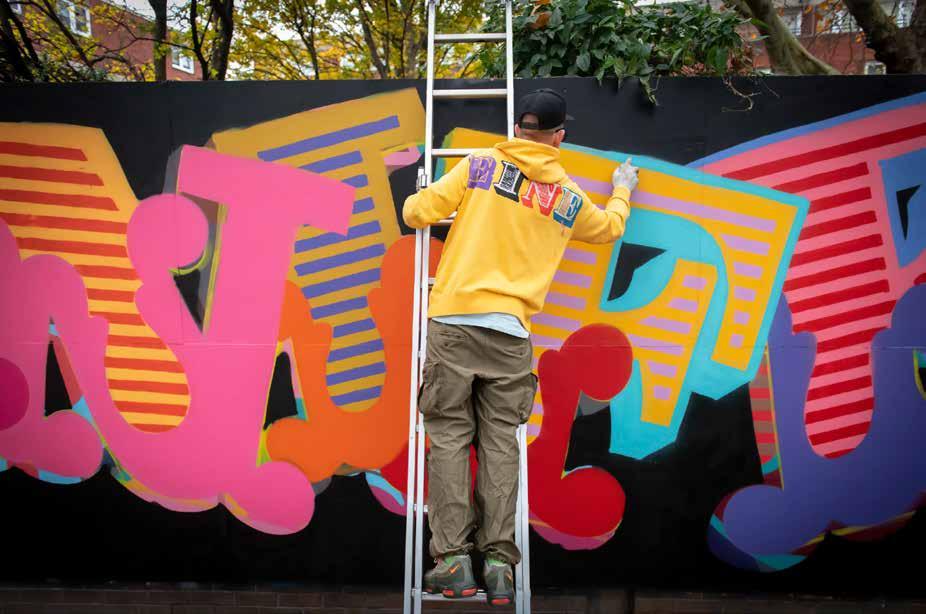
It’s two 50-year-old men who have known each other since they were teenagers, painting together
As for projects beyond four walls, the artist has many in the pipeline. He’s currently in the process of securing permission for a wall in east London that he’s been keen to paint for several years, though whether his wishes are granted won’t be stopping him from realising his vision. The location is of personal significance to Eine, and so he’s giving his choice of phrase careful consideration. “It’s a juggling act; I want people to read, it, question it, agree with it. I’ve wanted to paint this for a long time – and I might get arrested for it if I don’t get permission – so I want to do something that’s really powerful and meaningful,” he says. “I want to be sitting in that cell saying it was worth it.”
EINESIGNS.COM

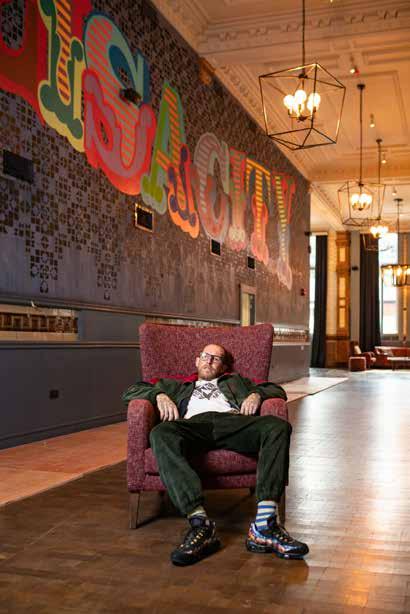
It’s a juggling act; I want people to read, it, question it, agree with it
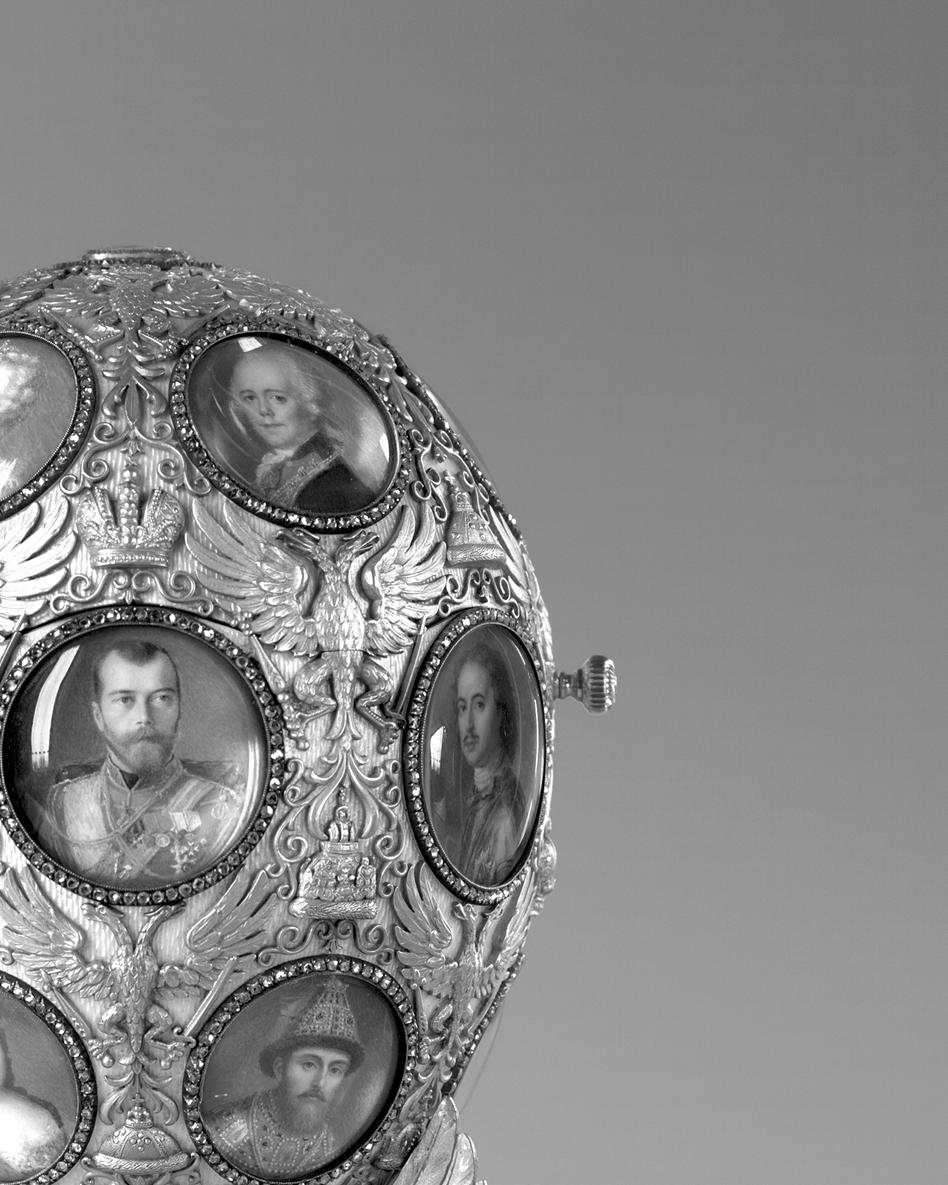 Photo:walter_g / Shutterstock, Inc.
Photo:walter_g / Shutterstock, Inc.
The Faberge brand is synonymous with sophisticated watches and jewellery and, of course, its famous eggs. But it began with a story of passion, secrets and incredible wealth
 Courtesy of Tatiana Fabergé
Courtesy of Tatiana Fabergé
The success of Fabergé, arguably one of the world’s most iconic artist-jewellery brands, began as a simple - if lavish - love story.
Tzar Alexander III decided to create a bespoke jewelled egg for his wife, Empress Maria Fedorovna, in 1885 to celebrate Easter – and their 20th anniversary.
Maria had often told her husband how, as a child, she had fallen in love with a jewelled egg owned by her Danish aunt. In secret the Tzar commissioned Peter Carl Fabergé to create the romantic gift – and the first Imperial Easter egg was born.
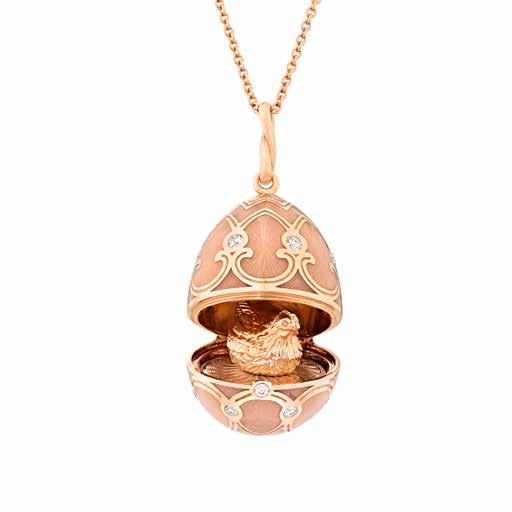
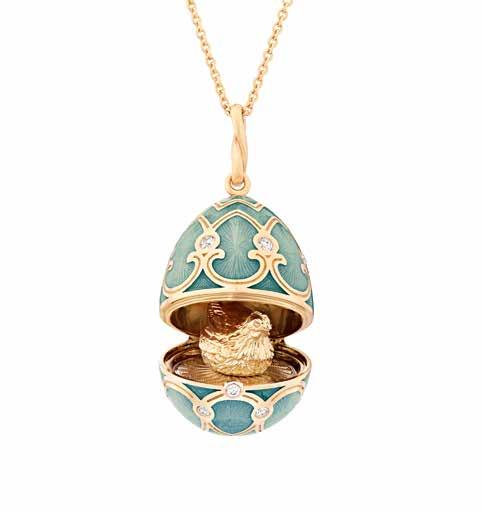
Easter was the most important occasion of the year in the Russian Orthodox Church and
a tradition of bringing hand-coloured eggs to church to be blessed and then presented to friends and family, had evolved through the years. Among the highest echelons of St Petersburg society, the custom developed of presenting valuable jewelled Easter gifts.
Yet this first Imperial egg was by far the most exquisite. Known as the Hen Egg, it was crafted from gold, its opaque white enameled ‘shell’ opening to reveal its first surprise, a matt yellow gold yolk. This in turn opened to reveal a multi-coloured gold hen that also opened to reveal a minute diamond replica of the Imperial Crown from which a small ruby pendant egg was suspended.
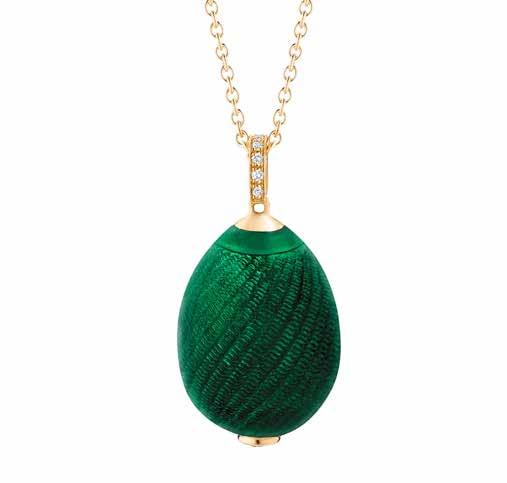
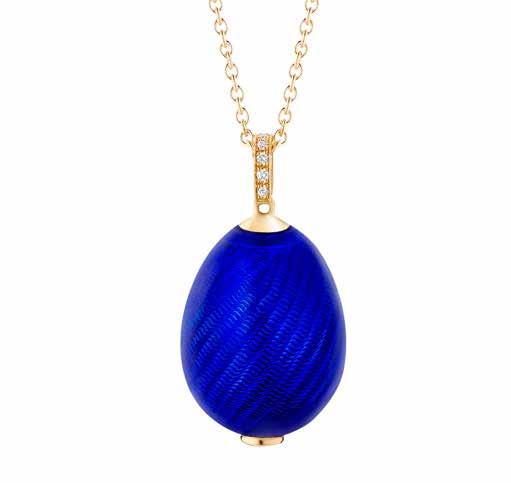
The success of Fabergé began as a simple - if lavish - love story
The Empress’s delight at this intriguing gift with its hidden jewelled surprises was the starting point for the yearly Imperial tradition that continued for 32 years until 1917 and produced the most opulent and captivating Easter gifts the world has ever seen.
The eggs were private and personal gifts, and the whole spectacular series charted the romantic and tragic story leading up to the end of the mighty Romanovs.
Each egg, an artistic tour de force, took a year or more to make, involving a team of highly skilled craftsmen, who worked in the greatest secrecy. Fabergé was given complete freedom in the design and execution, with the only prerequisite being that there had to be surprise within each creation.

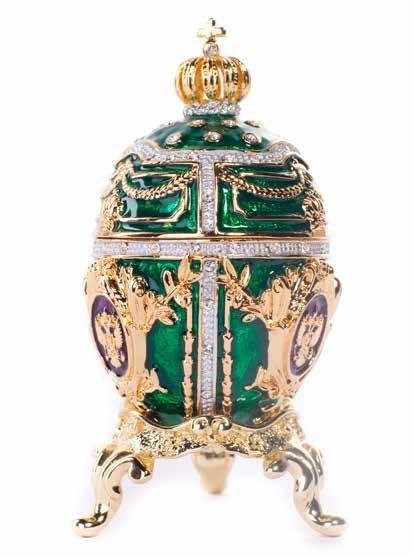
For sale – please contact Central Agent: chris@cecilwright.com
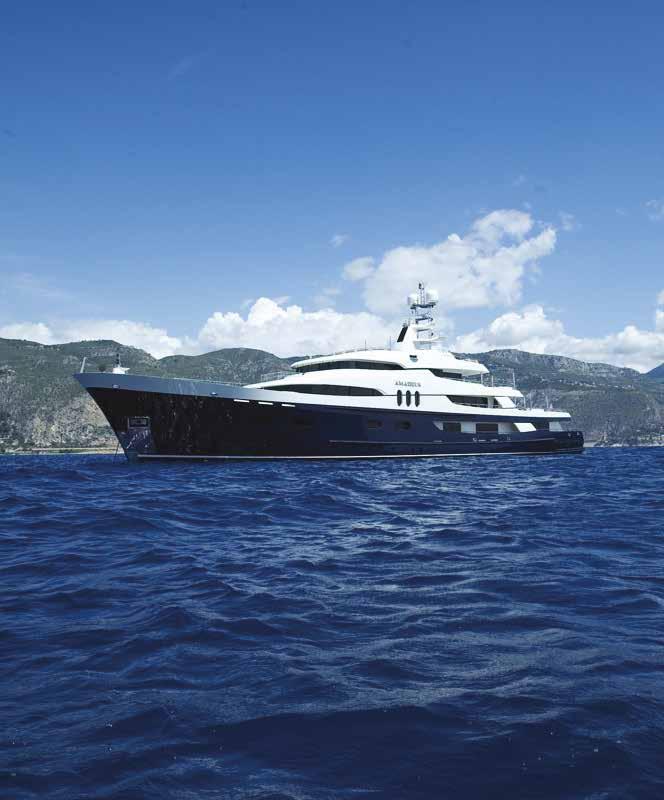
Dreaming up each complex concept, Fabergé often drew on family ties, events in Imperial Court life, or the milestones and achievements of the Romanov dynasty. The Fifteenth Anniversary Egg of 1911 commemorated the fifteenth anniversary of Nicholas II’s accession to the throne and the Romanov Tercentenary Egg of 1913 celebrated 300 years of the House of Romanov, showing portrait miniatures of the Russian dynastic rulers. Of the 50 eggs made for the Imperial family from 1885 through to 1916, 43 have survived and are exhibited in museums and privately all around the world. The late Queen owned three Imperial Eggs as part of the Royal Collection. One is the Mosaic egg, commissioned by Tsar Nicholas II for Tsarina Alexandra Feodorovna, for Easter 1914. Inside the diamond and rubyencrusted egg, is a miniature medallion painted on ivory with the portraits of the five children of Tsar Nicholas II and Tsarina Alexandra. It was purchased by King George V for £250.

The eggs were private and personal gifts and charted the romantic and tragic stories leading up to the end of the mighty Romanovs
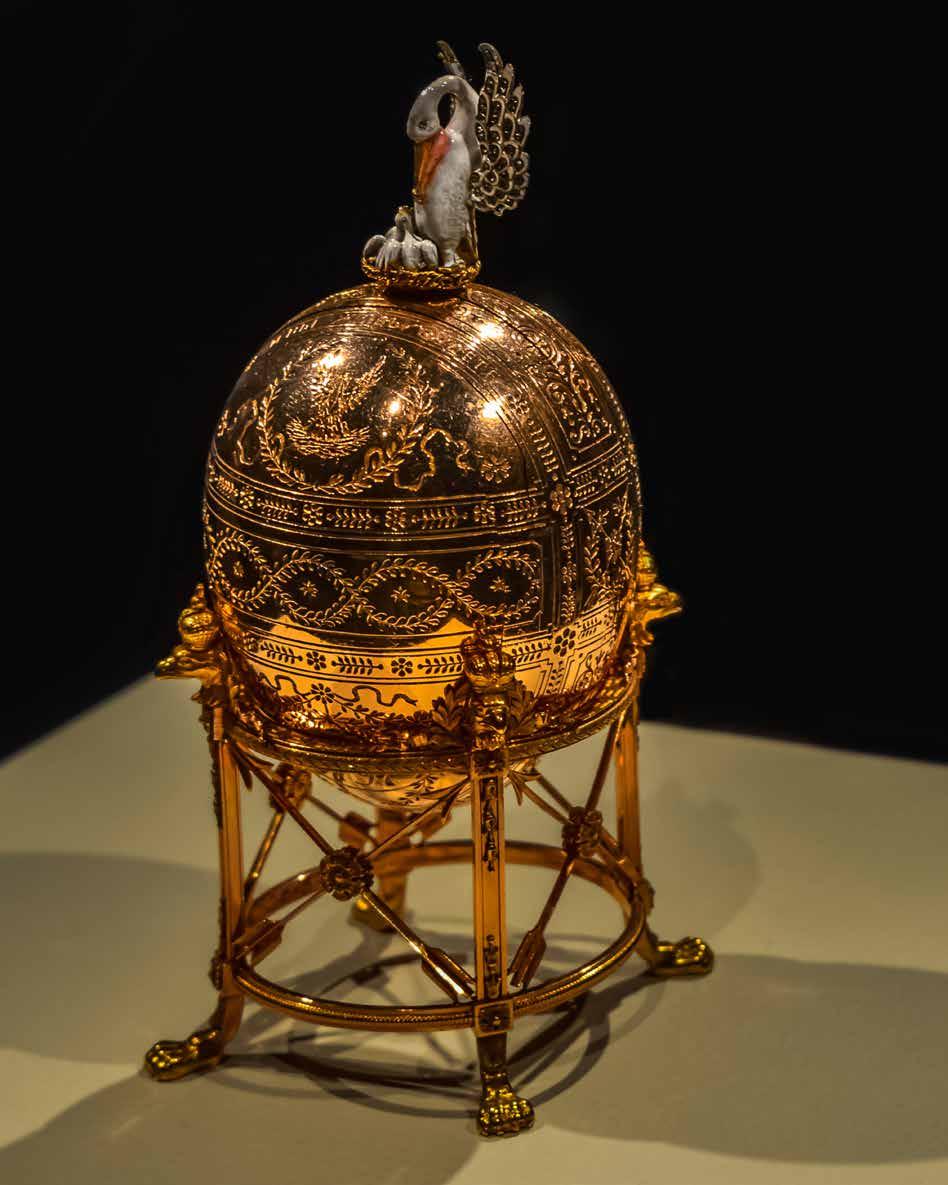
The Fabergé name lives on as one of the world’s most revered jewellery and timepiece brands. Current collections – often inspired by the past – are available at Fabergé boutiques in New York and London, as well as at Harrods.
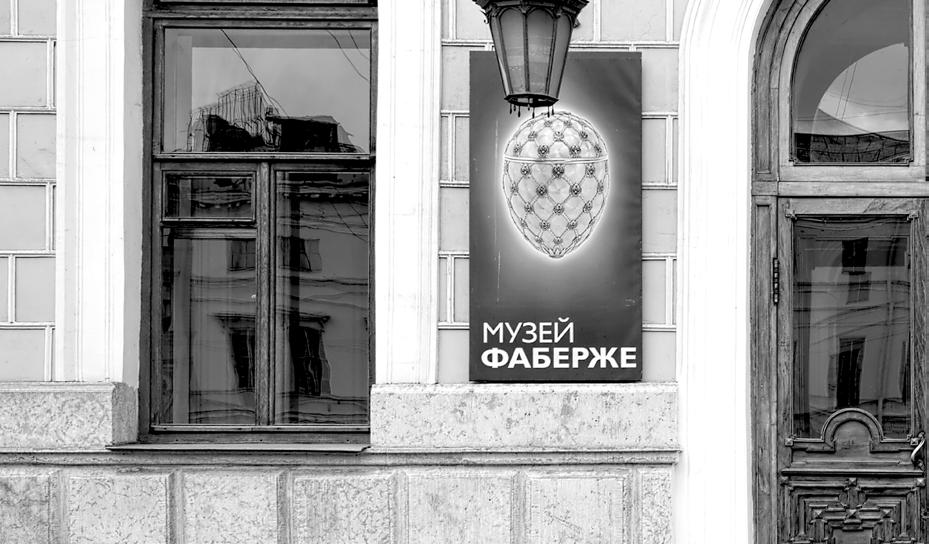
And still men and women buy their creations –as a token of love.
The late Queen owned three Imperial Eggs as part of the Royal Collection. One is the Mosaic egg, commissioned by Tsar Nicholas II for Tsarina Alexandra Feodorovna in Easter 1914.
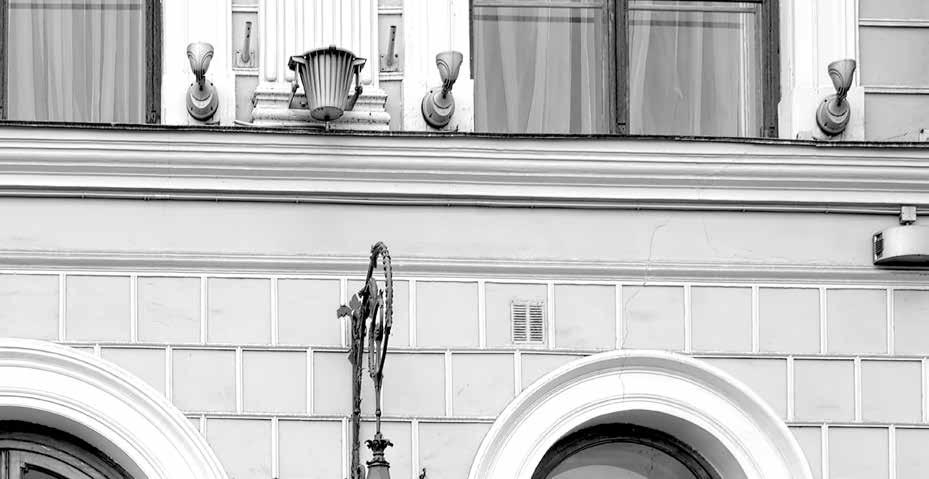
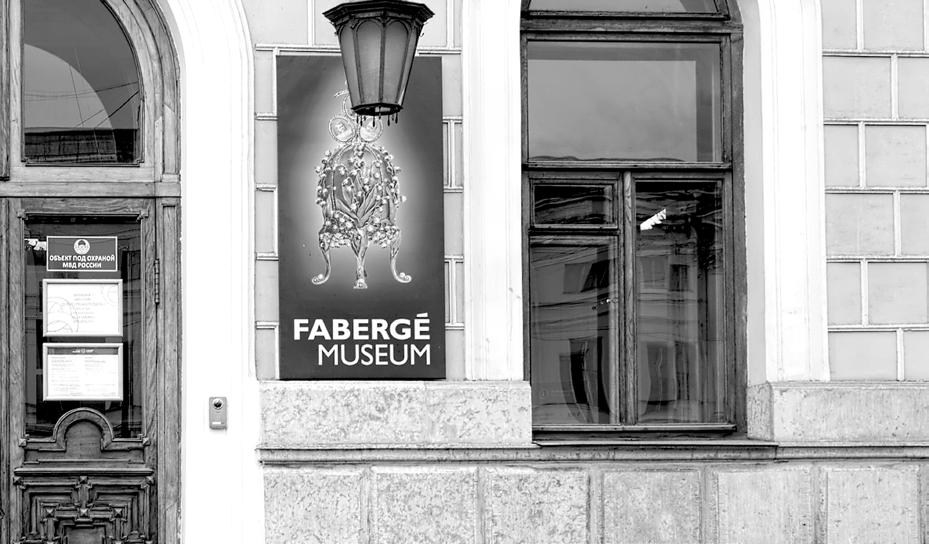
The aesthetic of the Fabergé Visionnaire DTZ is bold and contemporary but also reflects the renowned grandeur of Faberge’s historic legacy.
Fabergé has taken the masculine design of 2015's Fabergé Visionnaire I flying tourbillon and expanded it with dual timezones.

The self-winding DTZ adopts a logical and intuitive method of displaying two timezones simultaneously and employs a slim bezel, complex lug construction, multi-layered dial construction, fluted crown and a linear, decorative motif radiating from the centre of the dial.
Two versions of the Fabergé Visionnaire DTZ – one in titanium and 18 karat rose gold and the other in black DLC-treated titanium and 18 karat white gold – are offered by Fabergé. Both are presented on an alligator strap with matching gold and titanium folding clasp.
PRICE FROM £23,500
The Lady Compliquée Haute Horlogerie ladies’ collection upholds Peter Carl Fabergé’s tradition of surprise and meticulous execution with a time display exclusively developed for Fabergé by Agenhor Manufacture, which won the prestigious 2015 Grand Prix d’Horlogerie de Genève (GPHG) – the Swiss watchmaking industry’s highest honour – in the ‘HighMechanical’ category.
The display of the collection features a fan at the heart of the watch. The display in the Lady Compliquée Winter timepiece pays homage to the famous “Winter Egg” of 1913; the Lady Compliquée Peacock pays homage to the famous “Peacock Egg” of 1908 and offers four colour variations and feature emeralds, rubies, sapphire and diamonds.
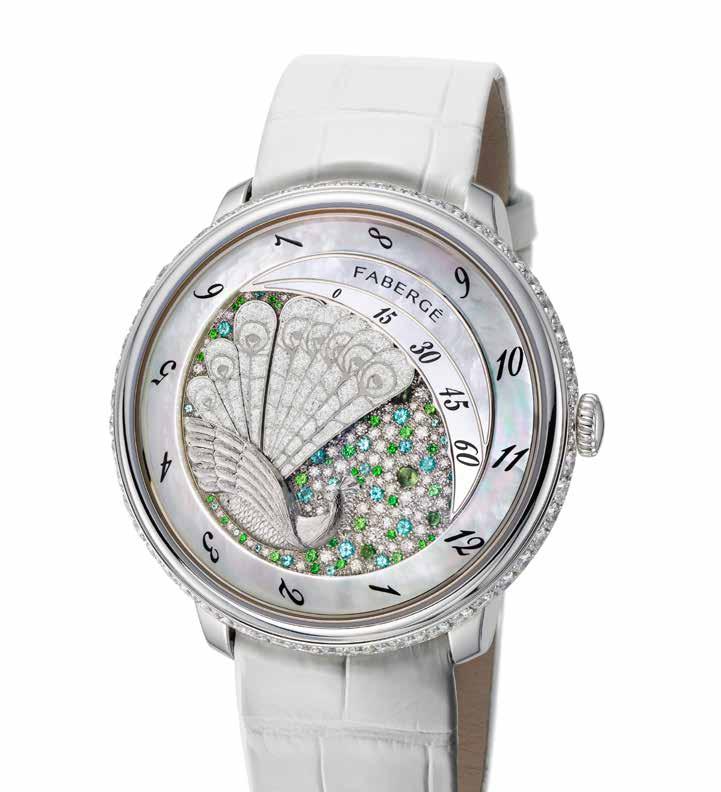
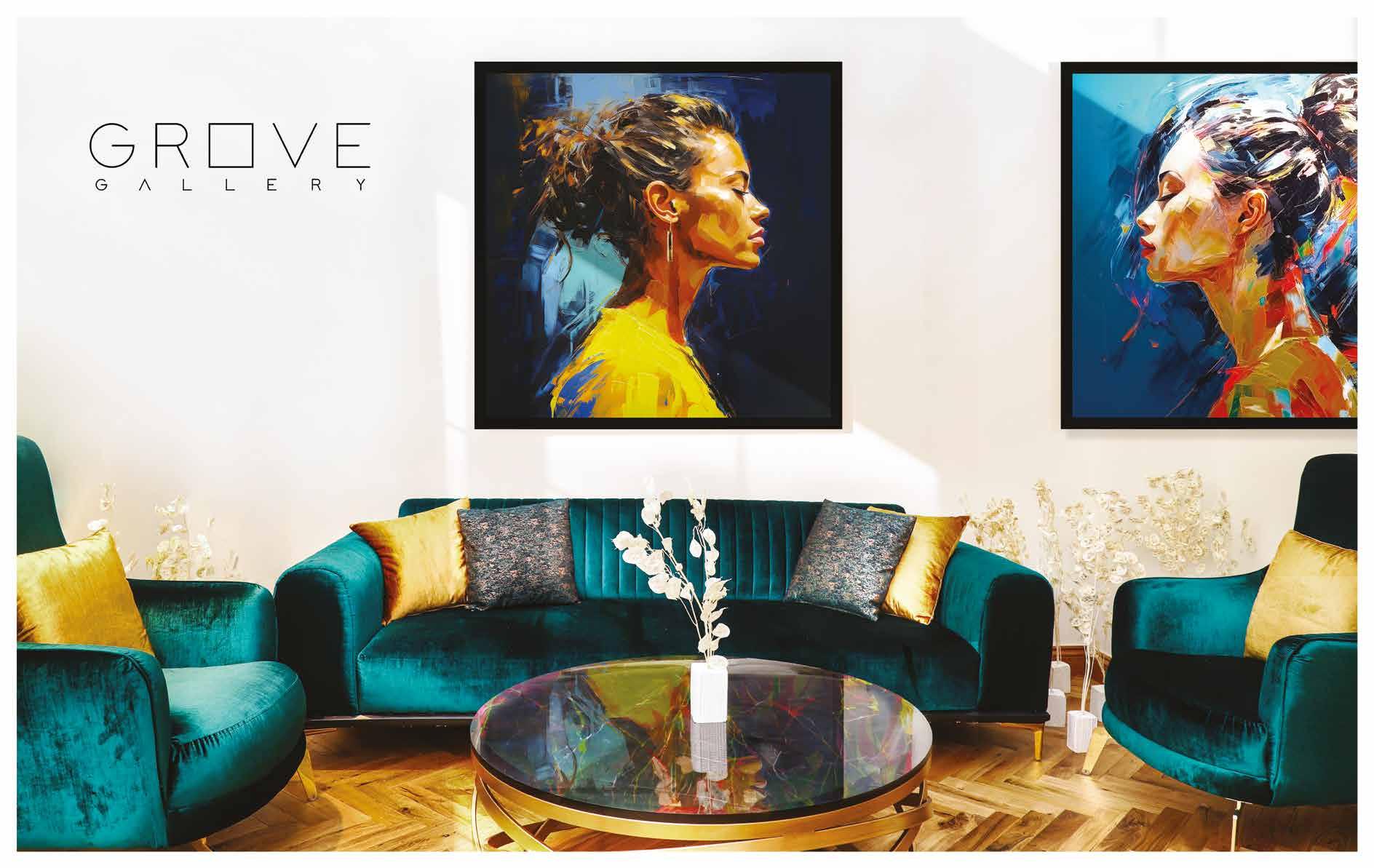



Once or twice in every century, it seems, there is something that arrives which changes things.’
So said Daniel Birnbaum earlier this year, the man who leads the Royal College of Art’s course on virtual and augmented reality and AI.
‘Photography changed not just the distribution possibilities of art, but actually the ontology of what an art piece can be,’ Birnbaum continued.
“Right now it’s similar to when the video camera arrived – or even moving film. It’s a transformation of that scale.”
Birnbaum could hardly be a harbinger of negativity for the use of AI in art; he runs a course
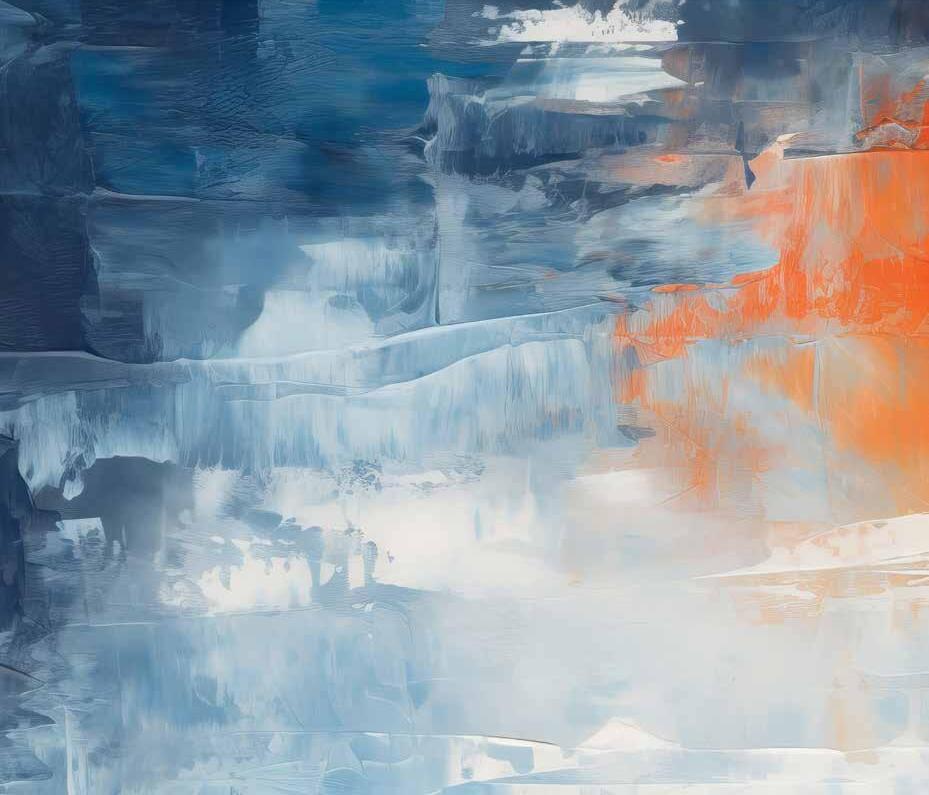
that is looking to charge over three thousand pounds to students for five days.
To dismiss AI art as mere copycat frippery is to negate the long history of how machines and creativity have interwoven. Yet the problem with looking back into history as a soothing balm to help us feel less anxious about the current rate of AI acceleration is that the examples the past throws at us are, consistently, not ones that everyday artists and creative pierrots of bygone ages could access.
When Ada Lovelace, the matriarch of computer science, worked as the amanuensis to Charles Babbage on his “Analytical Engine,” in the early 1840’s she imagined a machine that could have
AI-enhanced artistry continues to stir controversy in the creative sphere, but, Rob Crossan argues, it is simply the latest in a long line of aesthetic revolutions
artistic, not just mathematical applications.
The analytical engine was based on the Jacquard loom, which revolutionized the textiles industry at the start of the 19th century by feeding in punch cards which instructed the loom whether to stitch or not. By this method, a portrait of the loom’s inventor Joseph Jacquard, was woven into a tapestry on the loom with 24,000 punched cards, You could call this the first digitised image. But it was as accessible to the lay artist as the fresco of the Sistine Chapel.
Compare the quantity of punch cards plus the manpower and time involved in creating the portrait of Jacquard to the workload of Jason Allen,
who submitted an AI picture to a US state sponsored art competition last year and took home first prize.

Allen entered an artwork titled “Theatre d’Opera Spatial” to the “Digital Arts / Digitally-Manipulated Photography” category of the Colorado State Fair fine arts competition using a text-to-image generator called Midjourney.
Many fellow entrants claimed that Allen had been deceptive in submitting the piece, Allen, was robust in his defence.
“I wanted to make a statement using artificial intelligence artwork,” he told reporters. “I feel like I accomplished that, and I’m not going to apologise for it.’
What is the prompted work AI generates without the prompter
Yet Allen had, undoubtedly, participated personally in the creation of the piece. Creating an awardwinning painting depicting a production of Carmen requires more dexterity and articulacy than simply typing in, ‘stage/opera/light/Italy’ into a generator and waiting for your cash prize.
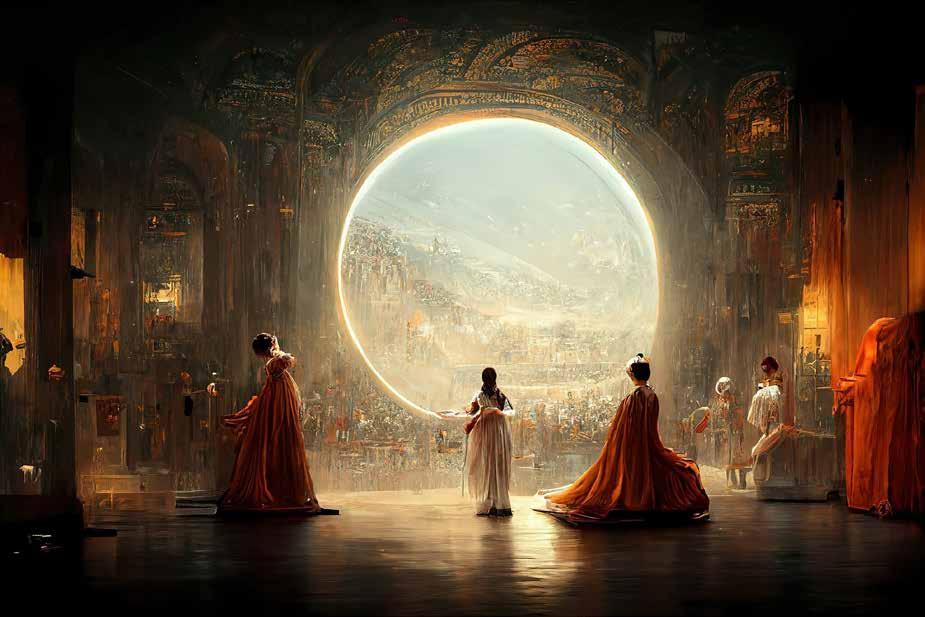
Hundreds of attempts at text ‘prompting’ have to be made to create what an artist is looking for. This is a typical example of a prompt created by New York AI artist and designer Nick St. Pierre.
‘35mm, 1990s action film still, close-up of a bearded man browsing for bottles inside a liquor store. WATCH OUT BEHIND YOU!!! (background action occurs)…a white Benz truck crashes through a store window, exploding into the background…broken glass flies everywhere, flaming debris sparkles light the neon night, 90s cgi, gritty realism.’
Perhaps it’s this kind of staccato didacticism, fused with chaos and randomness that appeals to Damien Hirst who, last year, embraced AI with his ‘The Beautiful Paintings’; These swirly, abstract pieces were entirely AI generated; available in both
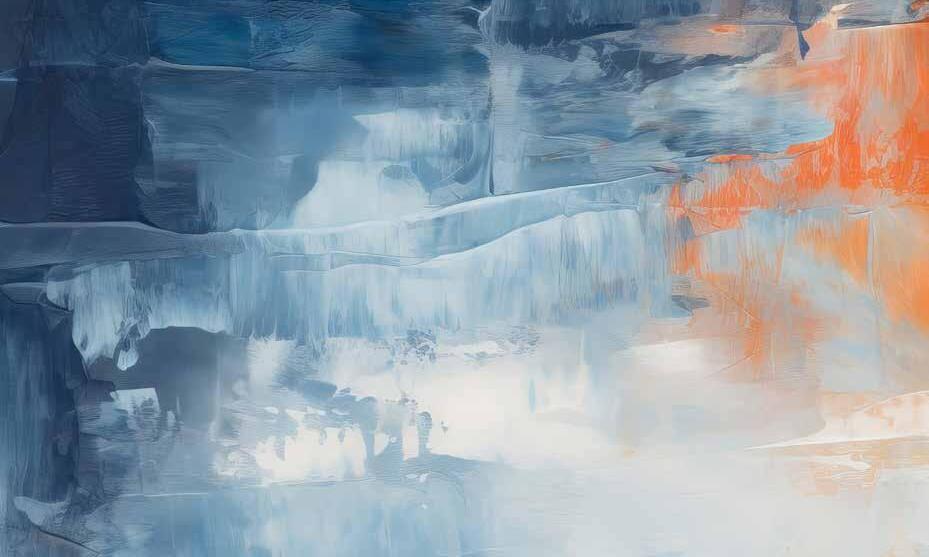
hand-signed physical wood versions and in digital only NFT (non fungible tokens) format.
Inevitably, the screams of ‘it’s not proper art’ aimed at Hirst, Allen et al are as bilious and fulsome as they were a century ago when Marcel Duchamp put a urinal into an art gallery. Some people are still screaming this message at the Dadaist, some 55 years after his death.
Below: Théâtre D’opéra Spatial by Jason Allen
The analytical engine was based on the Jacquard loom, which revolutionized the textiles industry at the start of the 19th century
Yet what is the ‘prompted’ work AI generates without the ‘prompter’? Surely, as long as the resulting work makes us feel something then it has fulfilled its purpose. And whether the artist completed the job in 15 minutes or 15 years is hardly relevant if it has an emotional impact on anyone who gazes upon it.
It can be argued therefore that if AI art is devious, then so was trompe l’oeil in its time. And, if the definition of art is something that is crafted by an uncommonly gifted hand alone, then we may as well also remove photography as a legitimate art form alongside AI and place them both where some would like to see AI stay; as a fairground novelty propagated by charlatans and conmen.
Yet, through this nascent era of AI art, it would appear that something approaching a distinctive style is emerging, despite the argument that the form is nothing more than a concertinaed and repackaged blitz of art history repurposed.
Looking at a series of AI art pieces generated by Midjourney last year, Roland Meyer, a researcher at Ruhr University Bochum in Germany, noticed some recurring features. Many AI pieces would “shine and sparkle, as if illuminated from within”, he said while many also displayed “high dynamic range”, meaning differences in light levels within the image.
And just as every pre-Raphaelite needed to know
something (however hazy) about art history, and what they liked and disliked, before they can truly create, so the AI generated artist also needs to know something of his forbearers in the analogue world.

Try typing a prompt into an AI art generator such as Midjourney, Jasper, NightCafe or dall-e-2 that you require a ‘Jackson Pollock Vienna street scene’. At best you’ll just get a smudged picture of paint on the road of a Google Street Map image. State Fair art prizes are not won this way. We AI art neophytes need to understand Jackson Pollock as much as Duchamp needed to understand Fauvism and Roussel before he could create.
But if there is a drawback to creating art using AI, it is surely the poverty of language’s ability to harness our deepest emotional reactions. This may explain why AI journalism and poetry is fathoms behind art when it comes to what we perceive as quality.
For example, asking Chat GPT to write me a song lyric about Goya, I got the following:
His legacy lives in each canvas, each frame, A testament to genius, forever the same, In Goya’s art, we find a reflection of self, A painter whose truth transcends death’s stealth.
Shameful stuff. And perhaps this is because words are, by their very nature, paid to be descriptive.
It’s only when we see a work of art that we admit to nothing more elaborate than that we ‘feel something’. Art is ineffable for, often, considerable amounts of time in a way that literature simply cannot replicate.
Just as AI is showing us just how weak it still is in terms of creating prose, in art it’s already begun the long shift away from cerebrally fooling us to emotionally moving us.
The drawback to creating art using AI is surely the poverty of language’s ability to harness our deepest emotional reactionsAbove: ‘The Beautiful
Paintings’by Damien Hurst


 By Sarah Jordan
By Sarah Jordan
There was a time when diamonds were thought to be of celestial origin, raining down from the sky in meteor showers and washing into river beds to be discovered. Because of this heavenly association, diamonds were considered to have mysterious, almost mystical qualities that mere mortals couldn’t understand.
Although we’d love for this to be the real story of the world’s most coveted gem, the truth is a little less fantastical and a lot more scientific. The earth’s natural diamond stores started life around three billion years ago, when carbon molecules began a transformation into meticulously arranged lattices. By the 1400s, the famous Golconda mine in India was unearthing some of the largest diamonds the world has ever known, followed by discoveries in Canada, Australia and South Africa.
Although these breathtaking finds were enjoyed by royalty, it wasn’t until the 1930s that women everywhere began receiving diamonds as symbols of love, devotion and commitment. Now, in 2023, it is the purity, strength and beauty of natural diamonds that continues to captivate audiences from all walks of life, cultures and corners of the globe.
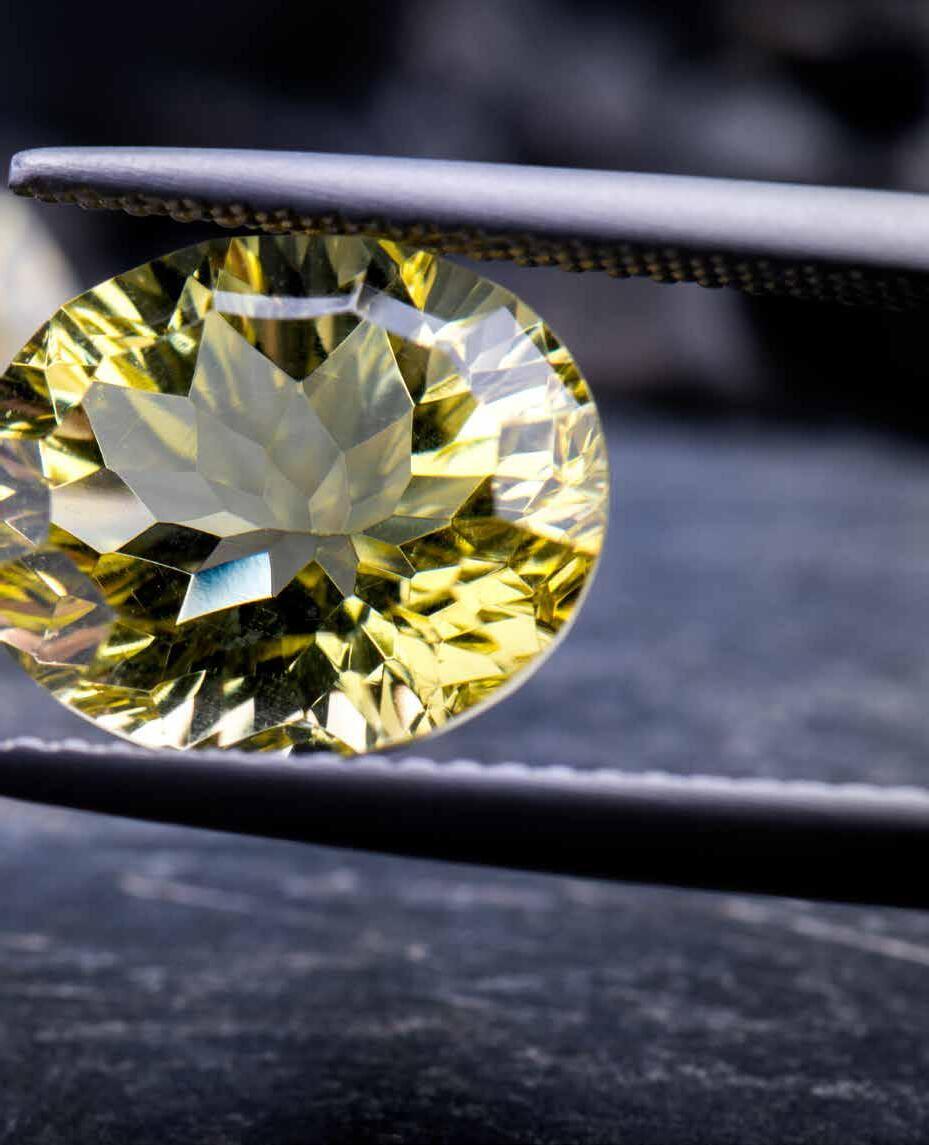
Of course, natural white diamonds are just the first chapter in the earth’s story. Coloured diamonds, like pink, yellow and blue, may be impossibly rare, but they are also just as beautiful. As Natwar Shah, chief executive officer of New York-based jeweller Shah Luxury explains; “Natural colour diamonds found in nature exhibit tones believed to exist only in semi-precious gems, when in fact, diamonds exist in almost every colour known to man. From faint pastels to rich and vivid dark hues.”
The most popular fancy colours for precious jewellery are pink, yellow and blue, with the latter causing quite a stir among diamond experts in recent times. In November 2016, a new worldrecord was set when the Blue Moon diamond – a stunning 12.03ct internally flawless jewel – sold for $48.4m at Sotheby’s auction house in Geneva. What’s remarkable, however, is that blue diamonds aren’t the rarest shade found in nature – that honour belongs to rich reds.
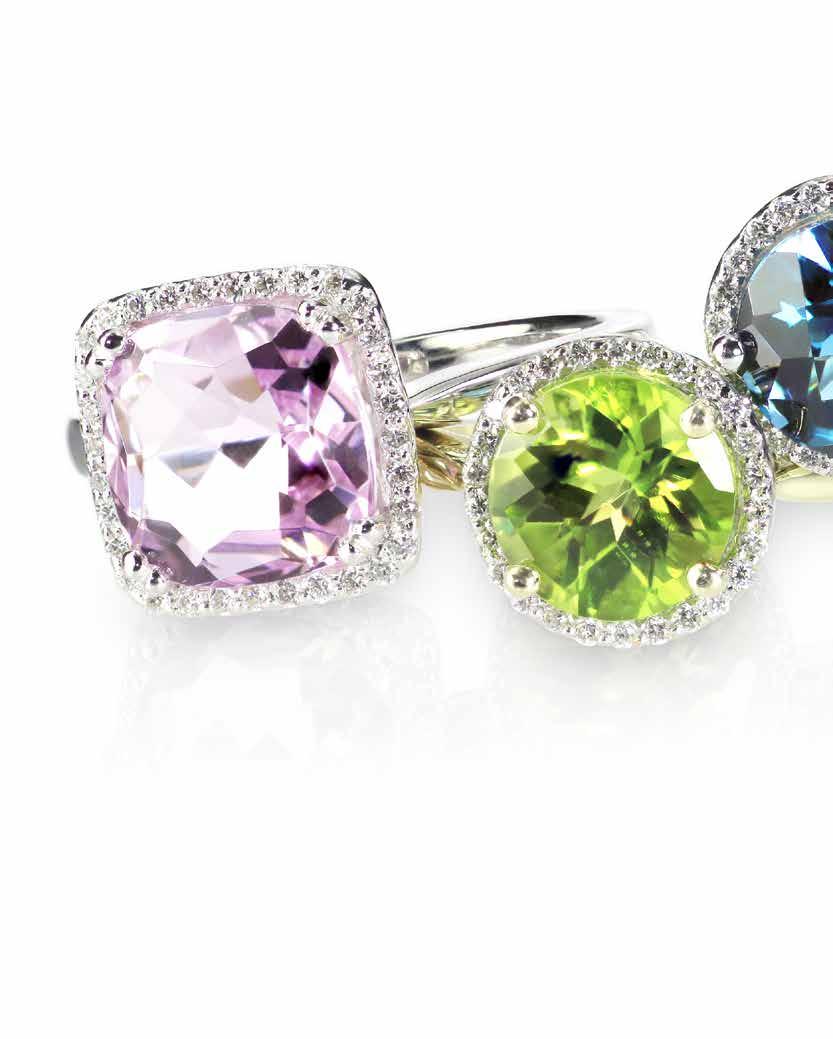
When shopping for the perfect white or coloured diamond engagement ring, nothing is more important than finding a ring that speaks to your personality. Combine this with a beautifully cut natural stone of excellent clarity and colour and you’ll be smiling no matter the carat size.
Just like fashion and beauty, there are trends in diamonds too. Over the years, the most popular cut for diamond engagement rings has always been the round-brilliant with 58 facets to reflect the light and add extra sparkle. However, 2023 has seen a shift towards more unusual designs, like beautiful cushion cut stones and vintage rose, French and Asscher cut diamonds. Jennifer Aniston wore a particularly stunning rose cut yellow diamond engagement ring, but fans of Hollywood glamour could also get their fix from an emerald cut stone worn by the likes of Beyoncé and Amal Clooney.
Diamond jewellery designer Ivonna Poplanska, who has created pieces for the late Queen Elizabeth II, says: “Thanks to celebrities like Kim Kardashian cushion cut diamonds have become incredibly popular. With the same number of brilliant style facets as the round brilliant cut itself, it creates a superb sparkle, while the rectangular cushion cut is great for creating a more elegant look and making the finger appear slender and elongated.”
So romantic types, take note this Christmas – nothing is better as a symbol of enduring love and commitment than a natural diamond. Their impervious strength and unending durability means they can be passed down to future generations – a symbol not only of your passion, but of family heritage and history.
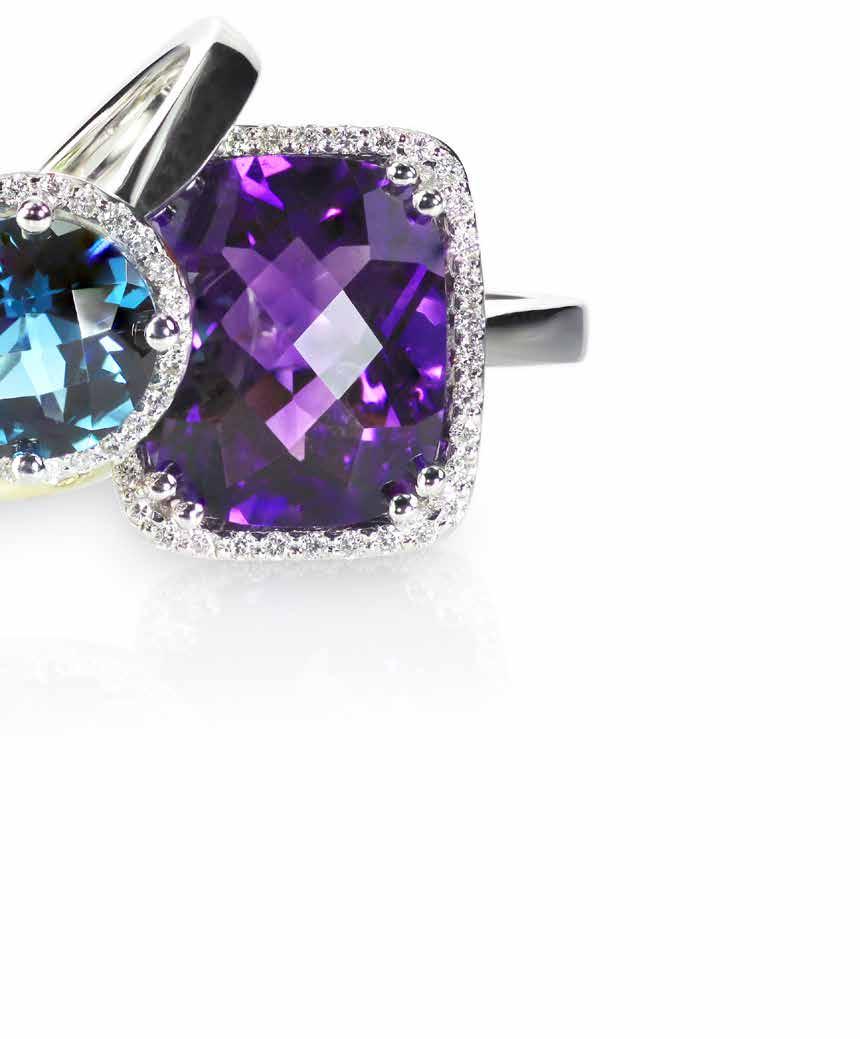
Thanks to celebrities like Kim Kardashian cushion cut diamonds have become incredibly popular.
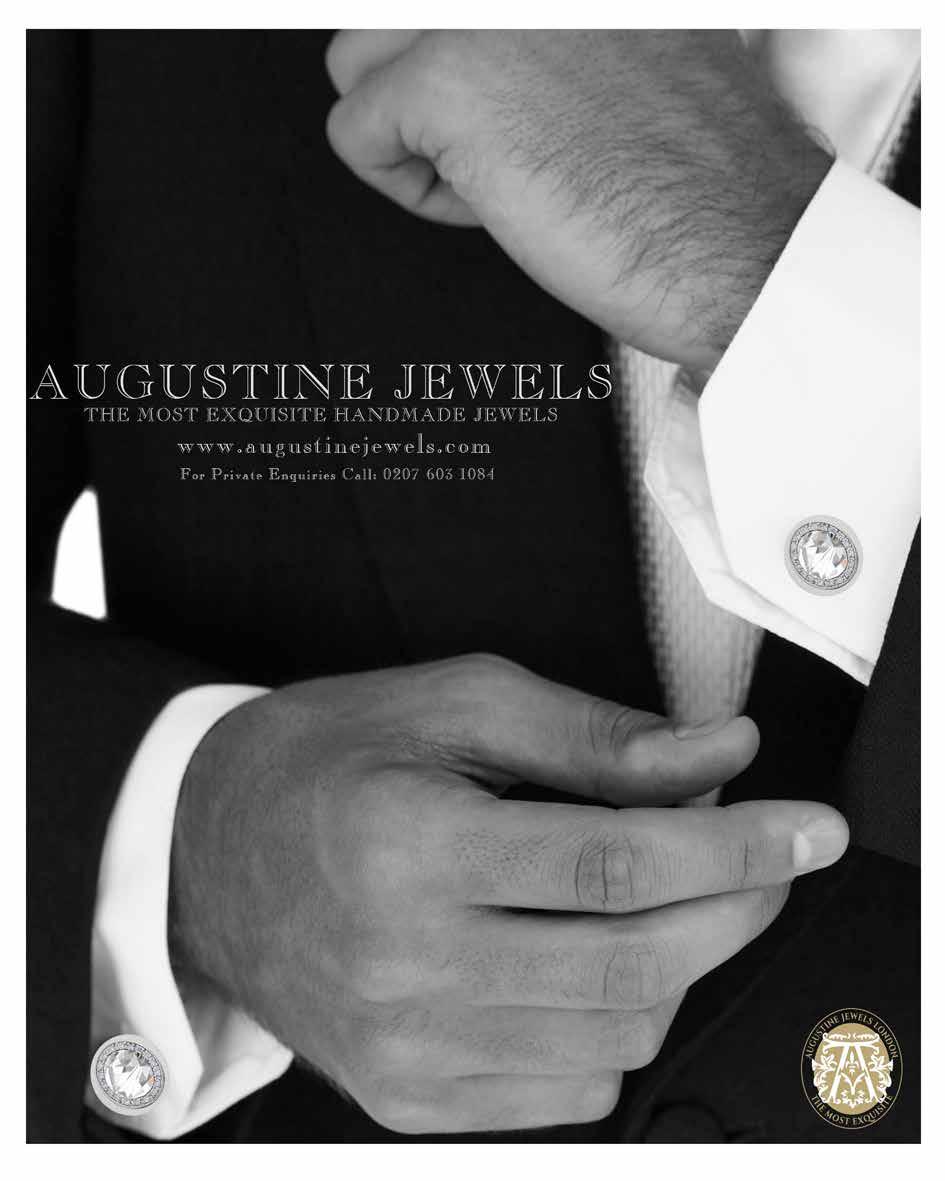
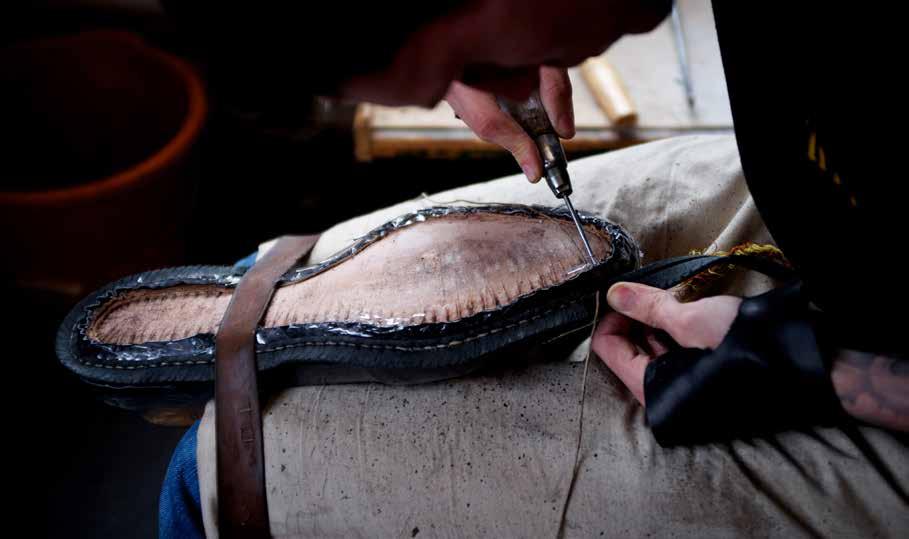 By Mark C O’Flaherty
By Mark C O’Flaherty
Many of Britain’s most elite artisans and heritage manufacturers have weathered the global hurricane of fast fashion. From the textiles of Johnston’s of Elgin that weave Hermés blankets to the Chanel knits that originate at the Barrie factory in Hawick, they remain in favour with some of the world’s most exclusive luxury brands. Certain small factories in England and Wales possess qualities that international design houses appreciate more than any other. Look at Dries van Noten’s last collection – virtually a love letter to his favourite British textile mills, with the logos of Lovat Mill of Scotland and Fox Brothers of Somerset writ large on the outside of his menswear. From shoemakers to milliners, the UK remains home to a certain kind of tradition that the world wants.

The oldest manufacturing factory in the world has collaborated with some of the most influential names in fashion history, including Vivienne Westwood, Paul Smith, Yves Saint Laurent and Prada. For over 230 years, John Smedley has been producing knits in Derbyshire. Today its name is synonymous with meticulous merino wool, sea island cotton and cashmere jumpers. This season, the company has produced the knits for The Vampire’s Wife, Longshaw Ward, Teatum Jones, Holly Fulton & Lou Dalton. Design and Marketing Director Jess McGuire-Dudley explains what continues to attract new, cutting edge designers to the factory: “They can gain a vast amount of knitwear knowledge from our teams and benefit from our machinery – both age old and the latest technology. They can also visit the John Smedley factory which is just 90 minutes from London, and experience our manufacturing for themselves.”

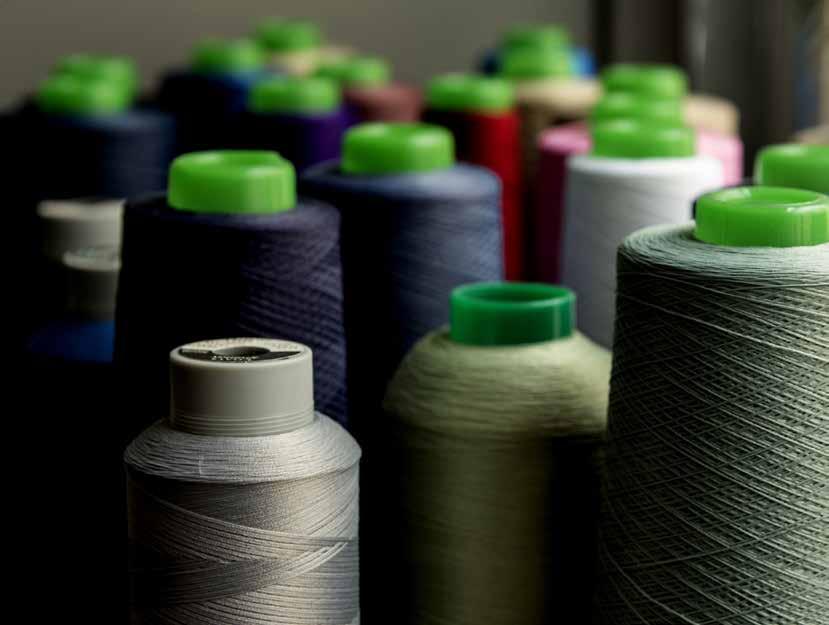
Designers love to delve into the archives at John Smedley, rummaging through thousands of pieces for new inspiration. The collaborations are driven by the most fundamental nature of clothing; rather than a cut or trim, it’s about the weave itself. “Some designers prefer to use fibre as a point of difference,” explains McGuire-Dudley. “Lou Dalton often works with our newer fibres such as alpaca, mohair or bouclé, and some, such as Longshaw Ward or Holly Fulton, create elaborate intarsia patterns, that are knitted using the most vibrant colours in our finest knits.” While Fashion Week benefits from the knowhow, John Smedley’s own product remains modernist and classic. Their grey v-necks are once prosaic and luxurious – you really can’t get better.
JOHNSMEDLEY.COM
When it comes to reputations in high fashion, Rei Kawakubo of Comme des Garçons in Tokyo is bullet proof. She is the designer’s designer – an avant-garde, intellectual icon. It’s significant then, that in her frequently reproduced official portrait, she is wearing a Lewis Leathers biker’s jacket. The British brand has been around since 1929, and is world famous among genuine bikers. Since its reboot in 2003, when Derek Harris bought the company, it’s attracted a new kind of attention. Harris began reshaping things before over ten years before as an employee, recalibrating manufacturing to make it as meticulous as it is modern.
“When I first got involved in Lewis Leathers in 1991, the product didn’t have the detailing it had in the 1960s and 1970s,” he explains. “I was spending time in Japan, looking at the denim revival, and the attention to detail in each item. I felt that if I brought back our classics, with the correct linings and zippers and detailing, we would meet a demand for quality in Japan that was the most discerning around – so it would be good enough for the rest of the world.”


When Harris took the helm, the profile of Lewis Leathers really took off in Tokyo – he accepted commissions from Junya Watanabe (operating underneath the Comme umbrella) for his MAN collections, and in 2005 Lewis Leathers created hitop trainers with Comme des Garçons. The collaboration with various brands in Kawakubo’s organisation has been consistent, and since 2012 a selection of hand-painted black leather biker jackets has featured at the main Comme des Garçons label, frequently featuring slogans created by Kawakubo herself.
LEWISLEATHERS.COM
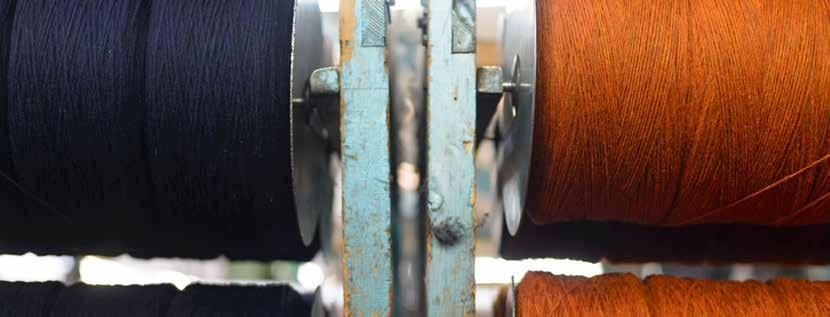
Harris Tweed, with its flecks and complex weave that echo the landscape in which it is produced, is such a part of Scotland’s national identity that it’s protected by an act of parliament. Only cloth produced in the Outer Hebrides can be marked as authentic and stamped with the distinctive orb emblem. As loved as the complex cloth is, just over ten years ago it looked like the industry might die out. In 2007, Harris Tweed Hebrides was founded, and with a contemporary approach to marketing, now accounts for 75% of all production in the area.
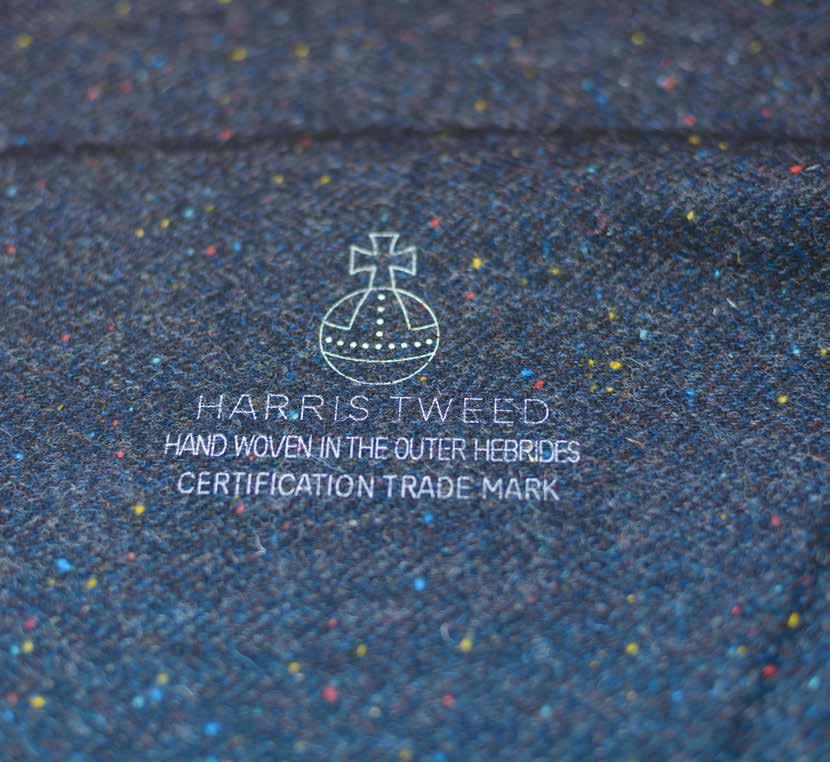
“The iconic ‘Clo Mor’ – gaelic for ‘Big Cloth’ – had become synonymous with stuffy gent’s jackets,” says Creative Director Mark Hogarth, “but the Shawbost Mill operated by Harris Tweed Hebrides has slowly updated that image over the past ten years.” The list of designers using the cloth is now epic, and this season is no different, as Hogarth details: “Manolo Blahnik used ‘plain’ yarn tweeds in a bright collection of heels, while Thom Browne used a variety of grey scale and monochrome for his season-defining womenswear collection. Prada came to Harris Tweed for the right balance of pattern and colour to fit with the corduroy and canvas of a 70's collection.”
HARRISTWEEDHEBRIDES.COM
Many discerning men in London talk about “Tricker’s” rather than “brogues”. The small Jermyn Street store is a place of pilgrimage for customers, who vary from bespoke regulars to fashion types eyeing up the new season offerings. The brand, which has been going since 1829, is also a favourite with designers who commission them to create collaborative brogues, usually co-branded to flag up their authenticity. Junya Watanabe has been working with them for years, as have Margaret Howell and Paul Smith and recently Mr. Porter.
“Spring is the second season we have collaborated with them,” says David Morris, the online store’s shoe buyer. “We have three exclusive styles. I adore the generations of expert know-how that goes into making these shoes; each individual item is painstakingly created via 260 processes.”
The master shoemaker at Tricker’s, Scott McKee, explains how the affection the brand enjoys today is grounded in function and authenticity: “From the outset, Tricker’s quickly became the maker of choice for farmers, estate owners and the landed gentry, who swore by the comfort, strength and practicality of its heavy, waterproof footwear. It’s no accident that Sir Edmund Hillary and his team chose Tricker’s for a Himalayan expedition in 1961 – the shoes and boots were virtually indestructible.”
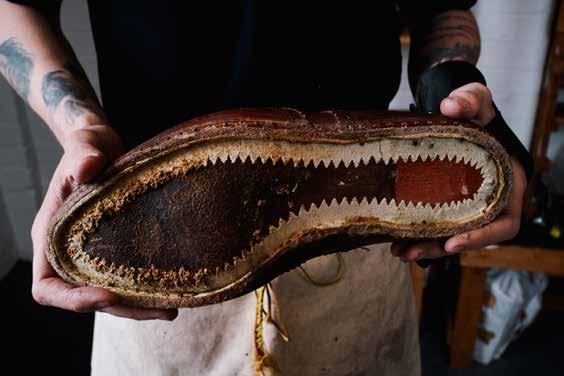

TRICKERS.COM


shockwaves
The most palatable pleasures revealed
The Davos of the wine world, Villa D’Este on Lake Como in an oenophiles paradise

After 250 days being hand-built the first Eagle Spyder GT has hit the road – collective jaws have dropped

Few can fault the original E-type – way ahead of its time in many respects. It’s hardly surprising, then, that when one E-Type owner took theirs for a modern day upgrade a new chapter in this classic car’s history would begin.
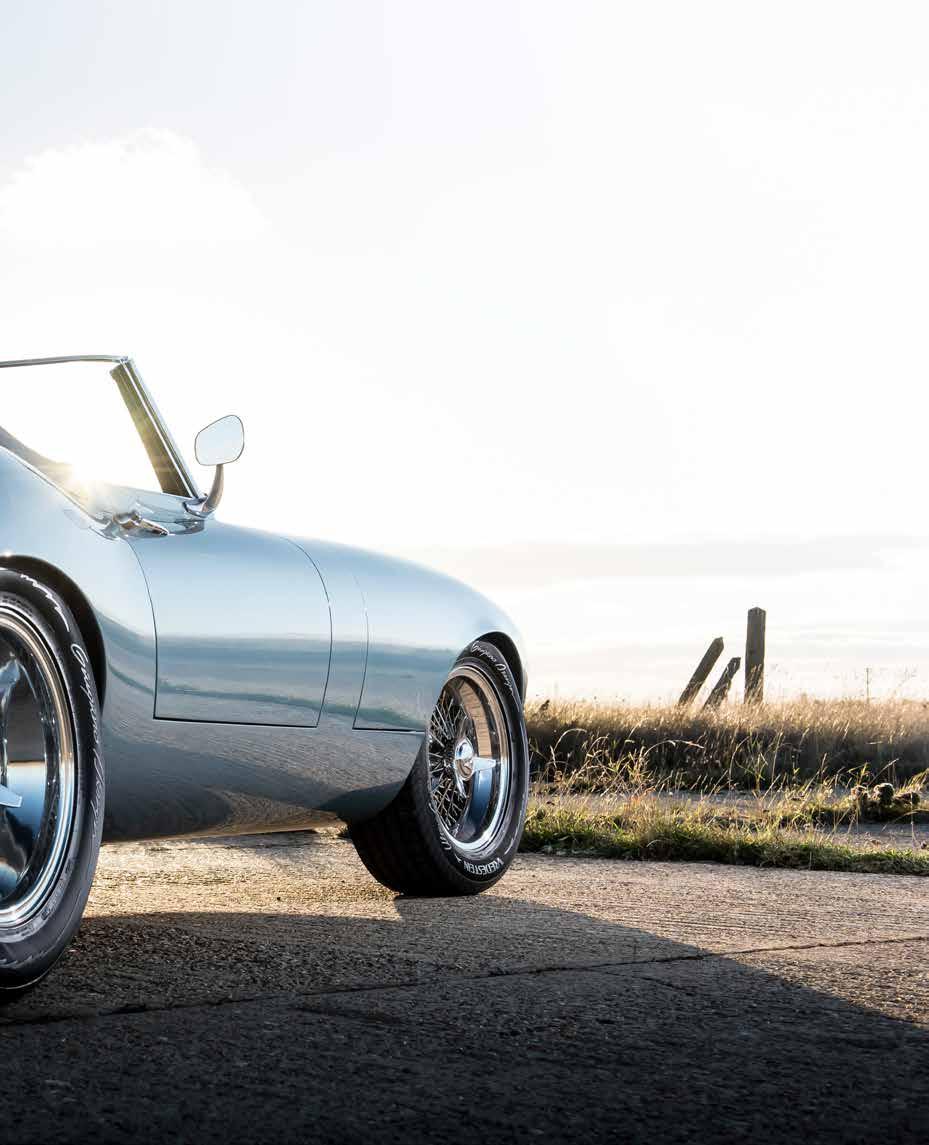
Eagle started off in 1984 as a traditional restoration business, buying, restoring and selling original E-Types to customers. Engineer Paul Brace joined the shop in 1989 and helped Eagles founder Henry Pearman transition it
into an outfit creating high-calibre “restomods”. Engineer Paul Brace joined the shop in 1989 and helped Eagles founder Henry Pearman transition it into an outfit creating high-calibre “restomods”.
The kickstart to the story that leads us toward this newly launched GT model started when in 1991, best-selling thriller author John McLaren came to Eagle. He wanted to keep the exhilarating experience his original E-type offered yet achieve heightened performance and reliability – Eagle E-types were born.

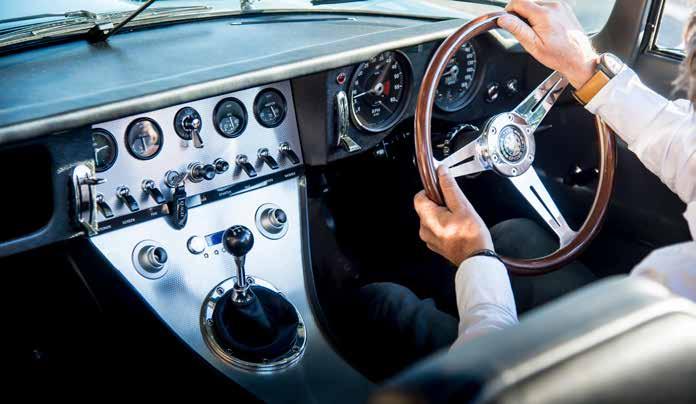

Twenty years after launching their successful Eagle E-Type restomod series, the Sussex outfit wanted to further ensure the E-type legend lived on and created the E-Type Speedster.
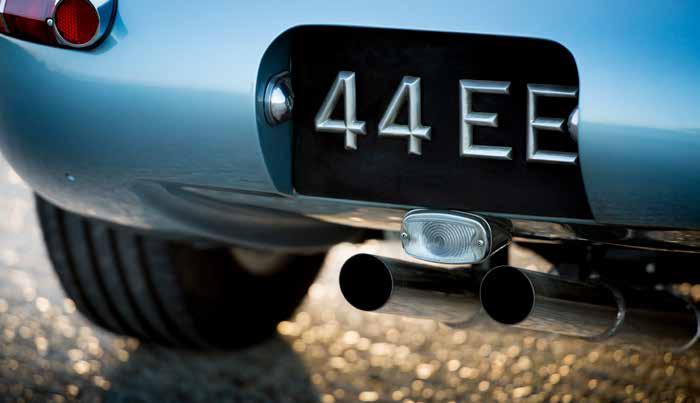


A couple of years later Eagle followed up with a hard-top grand tourer, the Low Drag GT. And now the Spyder GT completes their impressive trilogy.
The often savage circle of motoring critics have been roundly and repeatedly uttering words starting at gorgeous and moving through beauty and into jaw-dropping. It is as if they’ve all taken a collective intoxicant. Or perhaps not, we didn’t have any and are totally smitten.

And so to the specifications. It is more than a pretty face ( a very pretty one at that) and for its near £700k price-tag you’d expect quite a bit under the hood. We have 330bhp on offer thanks to a custombuilt, 4.7-litre straight six engine with power enough to propel the Spyder GT from 0-60mph in under five seconds, and on to a top speed of over 170mph.
And that, in a roof down ride is most certainly going to blow those cobwebs away and score high on the thrill factor.
Each ride begins life as an original E-Type ready for the long process toward GT glory. Each and every element is bespoke, from the aluminium gearbox to the engine block. The vehicle’s entire monocoque structure is also made up of the lightweight metal with deeper sills, a lower floor pan and wider wheel arches with custom 16” wheels and tyres
On the inside the hand crafted interior features sumptuous leather and a delicious sweeping centre console – the attention to detail is an absolute joy.
This car isn’t just establishing new levels in automotive excellence, it is redefining driving.
£834,000

Ever wanted to get serious about cigars? Well, here’s a handy guide to enjoying the finest smokes on earth
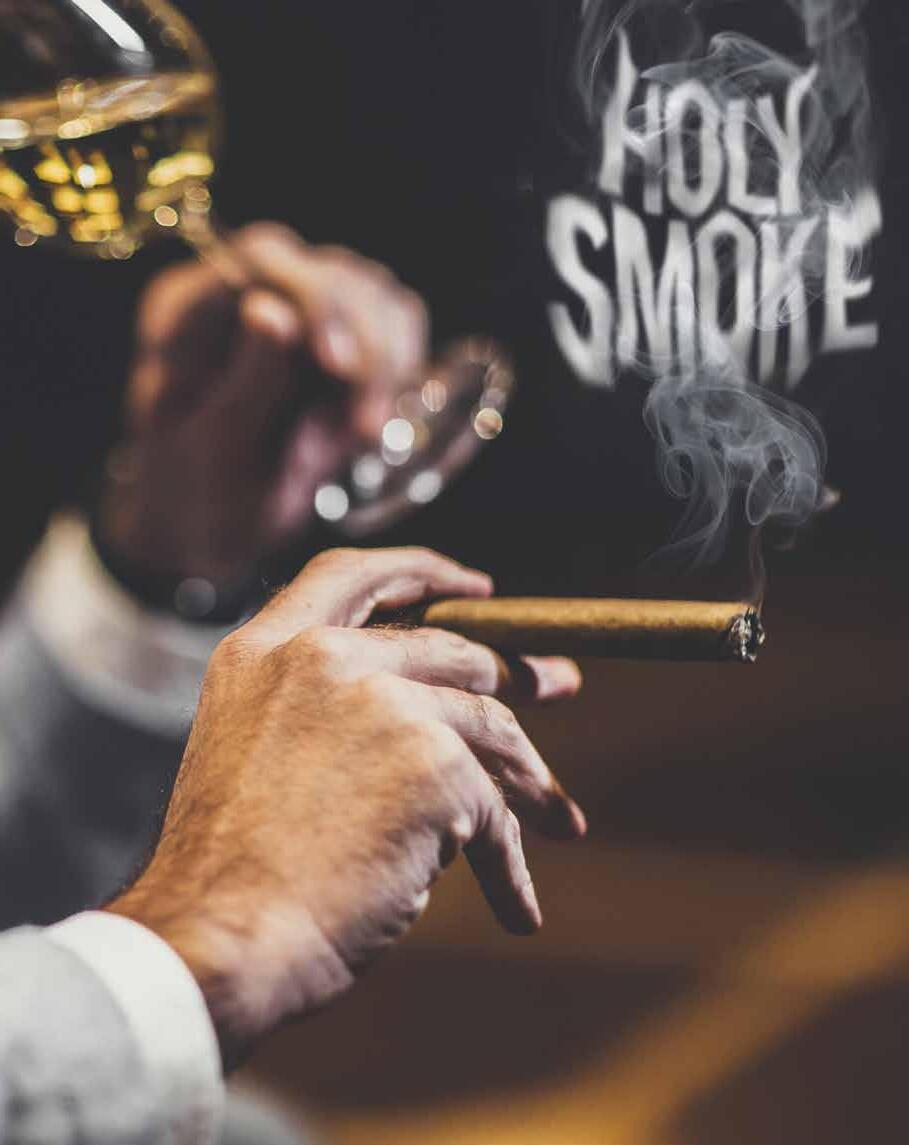 By Andrew Woods
By Andrew Woods
“Happiness? A good cigar, a good meal, and a good woman – or a bad woman; it depends on how much happiness you can handle.”
George Burns.Cigars are all about timing. The smoking of a cigar is not a mere pleasure of the moment; of any old moment. The smoking of a cigar is a momentous pleasure. One doesn’t draw in and swirl that fine-tasting smoke while waiting for a cab, say, as you might with a cigarette. The lighting of a cigar has significance. Maybe you’re enjoying a fine meal, a fine drink with a fine companion in a suitably fine location. The cigar is as much an acknowledgement of the best moments in life, as it is a pleasure in and of itself, which it undoubtedly is.
Although the cigar is intrinsically linked to the high life, with its luxurious shape, taste and trappings, its origins are much more primitive. Over a thousand years old, you can trace the roots of cigar smoking back to the ancient Mayan culture of Central America. The tobacco was picked from the plant by the peasants, before being tightly wrapped into palm or plantain leaves to keep it fresh. The term ‘cigar’ is thought to have come from sikar; the name
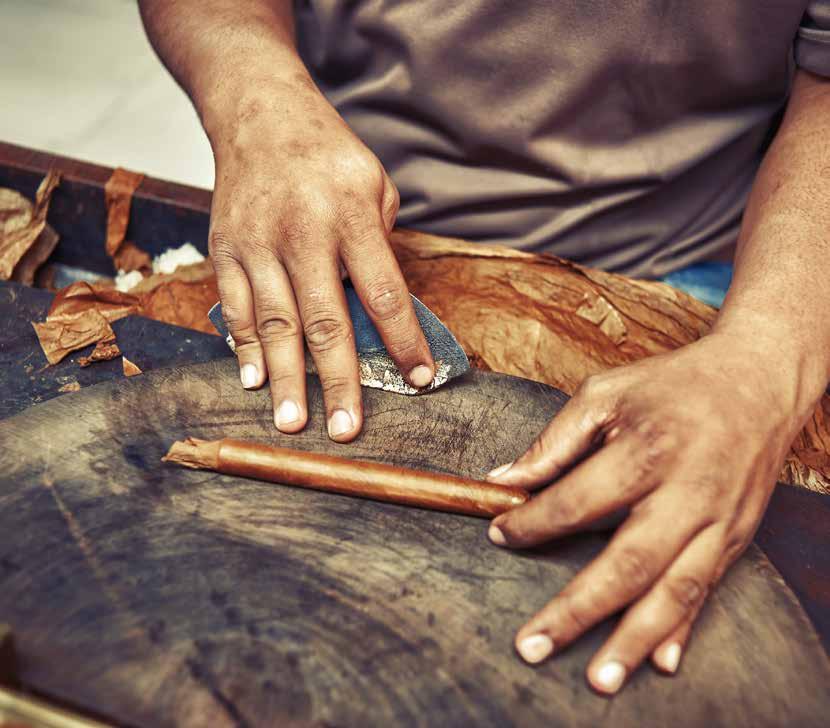
of the string the farmers used to wrap the leaves and tobacco together.
Europeans were introduced to tobacco by the native Americans in the 15th century and the popularity of cigar smoking spread right across Portugal, Spain and England as a result. Cigars were, by now, big business and a sign of wealth and status. Cigars would be smoked in the drawing rooms of the rich and noble and many members of royalty would finish a meal with a smoke.
The cigar is intrinsically linked to the high life
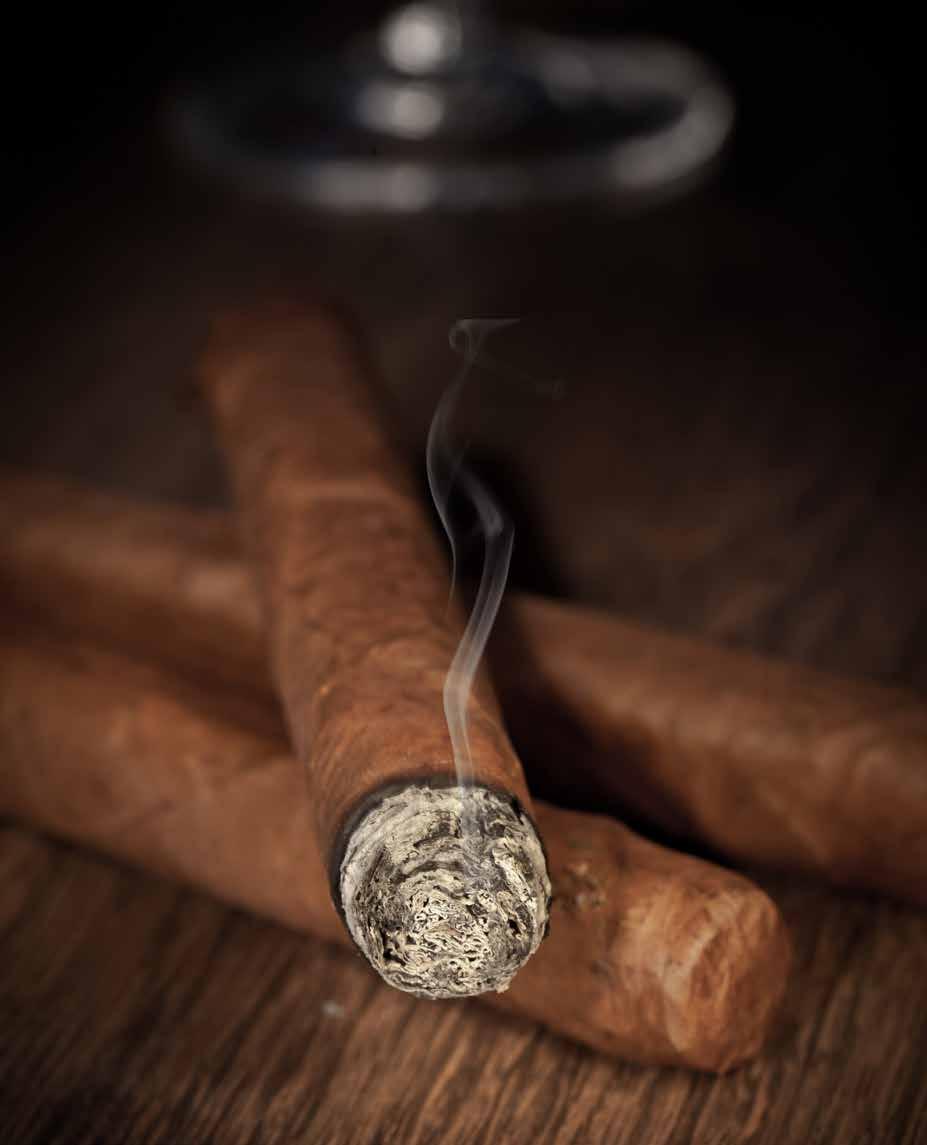
“The most elegant and sophisticated pairing to celebrate our best-selling cigar in a classic way is a Davidoff Signature 2000 with a champagne. The sizzling acidity of the champagne opens your taste buds to a quintessential taste sensation. Another extraordinary summit of pleasures is when a ‘Winston Churchill Toro’ – comman¬der among the Winston Churchill cigars – and ‘Glenmorangie Quinta Ruban’ meet. The manylayered ‘Toro’ harmonises perfectly with the complex sweetness of the Quinta Ruban with exciting variations over the entire three thirds of the cigar. Try a Swiss blended gin with a Davidoff Special R 702 Series. The gin surprises with delightful sweet and bitter orange notes and the cigar keeps pace with its typical roasted, milk coffee and wooden notes.
For aficionados who prefer richer flavours: Santiago de Cuba extra-aged rum with a Davidoff Yamasá Toro – the cigar starts spicy and in¬tense in flavours and is on par with the rum. An equilibrium with striking pepper notes combined with the sweetness from both the cigar and the rum. Neither cigar nor rum fight for attention, but instead com¬plement each other like a good friendship.”
It is largely held that Central America, and Cuba provides the perfect environment for cigar production and thus the ‘Cuban’ has an almost mythical quality, unavailable as it was (until 2015 at least) to Americans, due to its trade disputes with the communist country. US citizens can now consume Cubans on home soil, but are still prevented from buying or selling them. The significance of the Cuban is further heightened by the belief that each handrolled cigar goes through 222 stages before it is deemed ready.
There are thousands of different types of cigars available, primarily produced in temperate environments such as Cuba, Jamaica, Honduras, Mexico and the Dominican Republic. Even Europe (Italy and Spain) has produced many fine cigars.
There are two generic types of cigar from which most of the thousands of blends and sizes descend. The irregularly-shaped figurado was the smoke of choice in the 19th century. Expensive to produce, the figurado (including off-shoots such as the Presidente, Torpedo and Toscano) gave way to the more modern and cheaper to produce parejo, with its straighter sides. The parejo has that original cigar shape; a simple cylinder that closely resembles the cigarette. Popular parejos include Toro, Corona and Carlota.
Cigar smoking has long been associated with power and fame. The cigar was smoked in the boardrooms of big business and government, as well as backstage at theatres and film studios. From Mark Twain and Winston Churchill, through to Jay Z, Kanye West, Tom Hardy and Sharon Stone, the cigar has always been a sign of well-heeled cool. A sign of success.
1. Montecristo ‘80th Anniversary No.2’ Cigars.
This is a highly-thought-of smoke with a full-bodied blend of caramel, cream, leather, nuts and cedar. A box of 20 is £870 – and they’re worth every penny.
CGARSLTD.CO.UK
2. Davidoff Special R 702.
The line made up of the Signature, Aniversario, Grand Cru and Millennium series contains complex aromas mixed with heady scents. Some subtle and delicate, while others flood your mouth with rich, dark creamy aftertastes. A box of 25 is $535.
US.DAVIDOFFGENEVA.COM
3. Bolivar Coronas Gigantes.
Of the recent Cubans, we were mightily impressed by its notes of cinnamon, cappuccino, leather, coffee and spice. This is a powerful, yet understated smoke. A box of 25 will set you back £559.
CGARSLTD.CO.UK
4. E.P. Carillo Selección Oscuro Piramides Royal.
A dark and restrained Dominican blend that evokes chocolate raisins and dried fruit borne from a fantastically well-sourced array of tobaccos. A box of 24 trades at £141.16.

THOMPSONCIGAR.COM
5. King of Denmark.
The blend is secret, which is not surprising as it will cost you a cool £3,452 for a box of 60. For another £6,520 you can get the 24-carat gold-plated humidor with a sterling silver crown sat on top.
DANISHPIPESHOP.COM

Always sample a few ‘singles’ before committing to buying a box of them. Cigars vary immensely in taste so you don’t want a box of something that you wouldn’t even give to the gardener for Christmas. Give the single a quick inspection to make sure there are no cracks in the wrapper. Give the end of the cigar a little pinch to find any hard or soft spots.
“The quality of a cigar can be measured using clearly defined criteria,” HansKristian Hoejsgaard explains. “Criteria, such as the beauty of the wrapper, excellent construction and draw; the way the cigar is burning, which should be round. And the firmness of the ash. All the rest, such as the flavour and the aroma, is very subjective and depends on the aficionado’s preferences.”
Only cut a cigar when you are ready to smoke it. A cigar cutter will take the ‘head’ off; the head being the end you put into your mouth. Do not cut into the body of the cigar, aim for an eighth of an inch down as you bring down the guillotine. When you’re ready to smoke, take a butane lighter or a wooden match (so as not to introduce any chemical tastes) to the end of the cigar once you’ve popped the other end into your mouth. Then light the cigar as you draw and twist it. It should take 50 seconds until it is fully lit. Then take the smoke into your mouth and exhale without inhaling. Now, sit back and relax. This moment is yours.
So, when is the best time of day for a cigar? “In the morning, the palate is fresh so the first cigar of the day is often considered the most pleasurable,” says Hoejsgaard. “In this case a mild cigar is best suited but, as always, this is a personal choice.
The cigar that follows a midday meal should be the meal’s apotheosis and crowning glory, complementing the food. Therefore, a meaty meal with rich sauces suits a robust cigar; while a complex meal needs a cigar with great intensity and strength; after a lunch light in calories, a delicate cigar is suggested. The time for a larger cigar in terms of size, power and complexity, is after a fine meal, in the evening, accompanied by wine and followed either by liqueurs or a simple cup of coffee, or both. If a second cigar follows, it must be strong enough to dominate the first.”
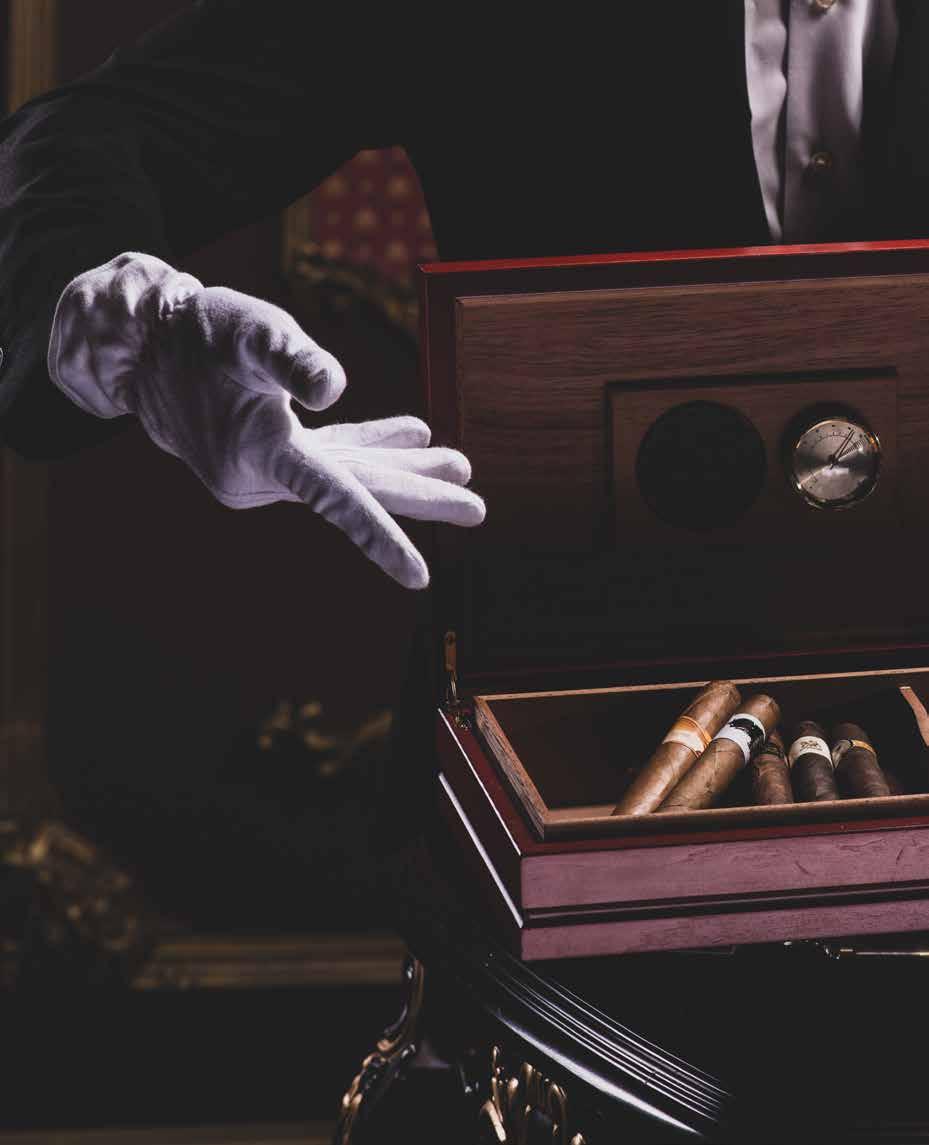
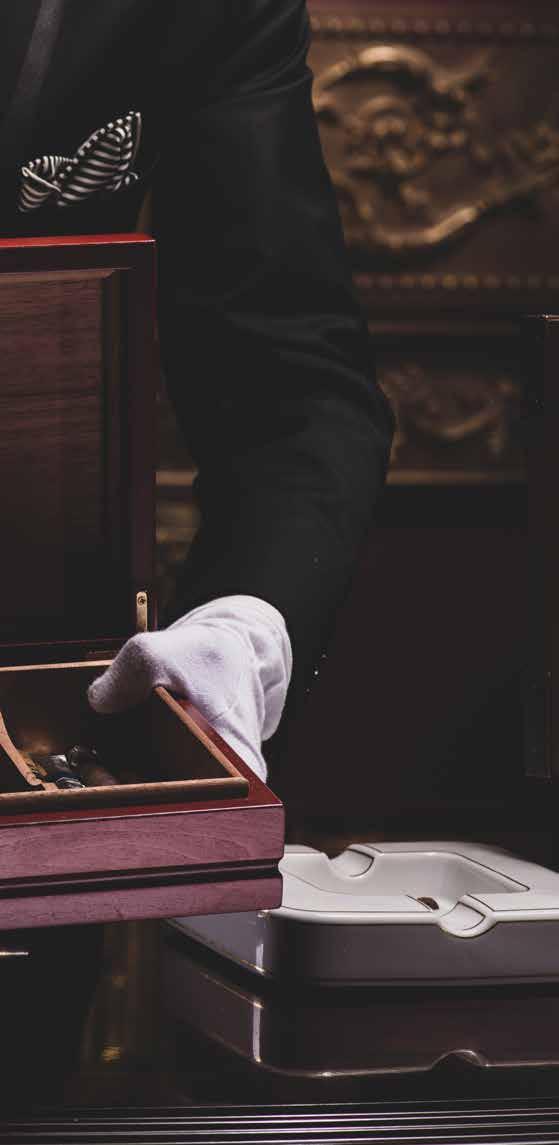
So, who are the finest purveyors of cigars? A cigar shop is a very special place. Ambience is everything in these boutiques where time stands utterly still. Davidoff on the corner of London’s Jermyn Street and St James’s is regarded by many as the best cigar shop in the world, while The Wellesley Cigar Terrace in Knightsbridge is a great place to buy and have a smoke; you can even bring your own cigars. New York is possibly the cigar capital of the western world right now with some incredible shops, such as Barclay Rex (126 Pearl St, in the heart of Wall Street) and the Cigar Inn (334 East, 73rd Street) and three Davidoff stores (230 Vesey St, 515 Madison Avenue and 1390 6th Avenue). Unsurprisingly, the United Arab Emirates has a great choice of cigar shops and bars too including the seven-star Hotel Havana Club in Abu Dhabi. Of course, the ultimate cigar lounge is in Havana itself. The Partagas Cigar Lounge in Old Havana, Cuba has one of the world’s largest, and rarest, cigar collections.
Traditionally, a cigar has always been synonymous with rich liquor and the ability to pair a cigar with the perfect drink is a skill. A seasoned smoker will know the exact cognac, whisky, wine or port to pair with their smoke of choice. Such is the powerful taste of a cigar, they tend to suit drinks of an equal strength, hence beers, vodkas and gins tend not to work so well. As a rule of thumb, the lighter the cigar, the lighter the drink. A wine would suit a light-bodied cigar whereas a full-bodied smoke would require a heavy single malt. Tequila works surprisingly well with some lighter blends.
Whatever you choose to smoke, ensure you enjoy it slow. Cigars are a pleasure too good to be hurried.
In one of the world’s most romantic settings, the great and good from the world of elite wines gather to discuss the past, present and future of the noble grape
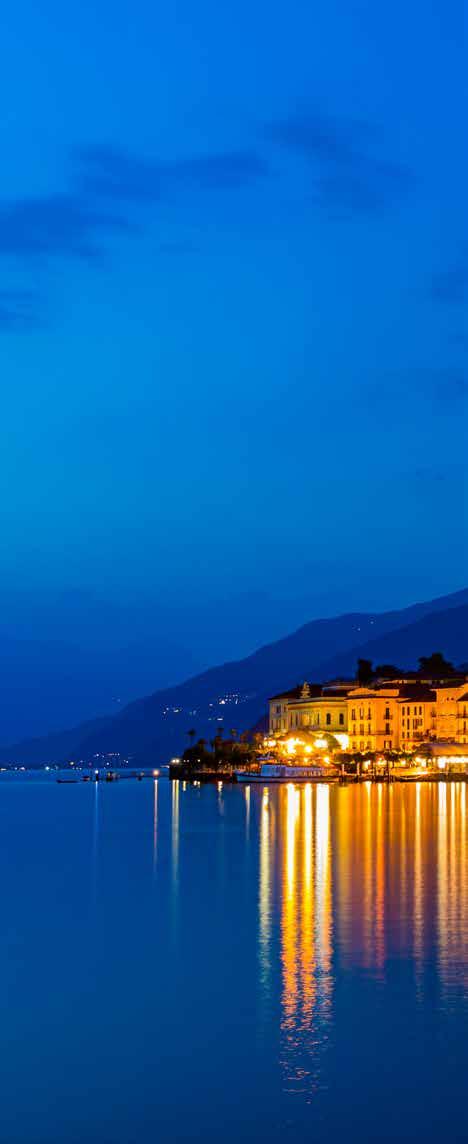

There is a yak roaming the cloud-covered hillsides in north Yunnan, south-west China, who’s set to be the talk of the finest dinner parties in London over the coming months and years. Because this yak – let’s call her Yasmin – has, in no small way, helped to create one of this year’s finest and most unusual wines.
Ao Yun is a new premium Chinese wine made by LVMH group’s Möet Hennessy Estates & Wines, which owns Dom Pérignon, Krug and Château d’Yquem, and is the first serious fine wine to come out of China. The name means ‘roaming above the clouds’ and is a reference to the landscape of the remote area where the grapes are grown, at the edge of the Himalayan mountains, not far from the city of Shangri-La. The 2015 vintage is rich, deepcoloured, with a spicy tang, hint of liquorice and a silky-smooth texture. It’s nearly 15 per cent alcohol and tastes truly unique.
Yasmin – and, to be fair, also her family and friends – helped create Ao Yun wines by pulling a plough across the high-altitude terroir. Moreover, the natural fertiliser produced by these longhaired bovines was used on the soil to help the vines grow. And yak fertiliser, I learned, gives the grapes an interesting and rare under-note.
I’m aware of Yasmin and her fellow yaks thanks to my attendance at a wine symposium at Villa d’Este on Italy’s Lake Como.

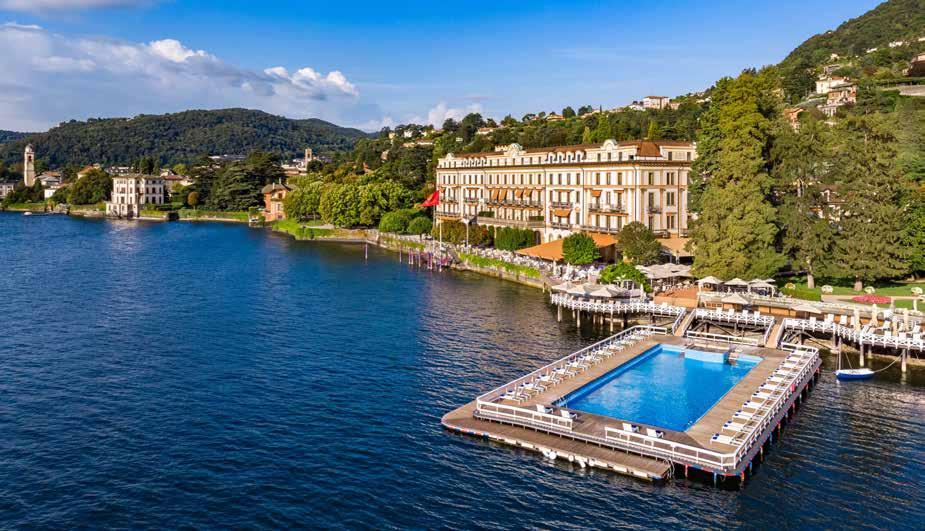
Should you be unsure, a yak is a long-haired bovine found in the Himalayas and Tibetan plateau. A symposium is a gathering of knowledgeable people who meet to discuss a matter of shared interest. The Greeks invented the symposium – and wine was frequently drunk throughout.
It is very apt, therefore, that Villa d’Este chose to call this annual gathering a symposium rather than a conference, fair, tasting or show. Held over three days in the autumn – when the throngs of tourists have left Lake Como and the autumn colours make the location even more stunning – the exclusive event has attracted the great and the good from the world of elite wines for 10 years, and hosts around 200 high-net-worth guests (think Davos with bottomless fine Burgundy).
Wines at the tastings, lunches and dinners range from a few hundred pounds a bottle to many thousands of pounds. For the most exclusive wines, like the Domaine de la Romanée-Conti (DRC), there’s an extra price tag of up to £2,000 per tasting seminar on top of the attendance fee, which is approximately £4,000.
Breakfast, lunches and dinners are all open seating. Far from it being intimidating for a lone novice like me, conversations are shared between gracious and encouraging producers, experts, wine collectors and investors from all over the world.
Cards are exchanged between the symposium
guests and arrangements are made to see them at the same time, same place next year. Firm friendships are formed and, in my case, there was an out-pouring of sympathy offered regularly from fellow guests that the UK was no longer part of the European Union.
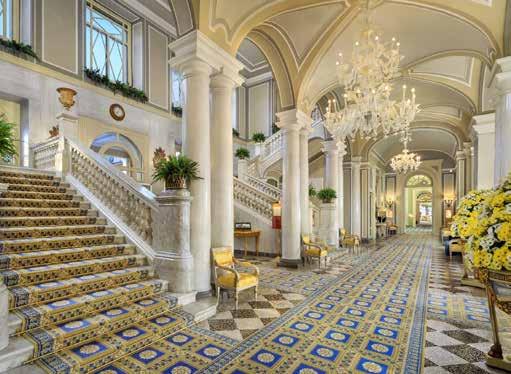
The annual affair is not just for producers, buyers and restaurateurs – anyone who enjoys acquiring fine wines for their cellar is welcome. This makes for a special mix of enthusiasts who have a shared goal of discovering and enjoying the world’s finest wines.
Established and traditional production methods sit alongside new innovative scientific formulations on the programme of events and discussions.
Guests can sample fine wines and champagnes from worldwide producers every lunchtime and there are lectures, tastings and round-table discussions spread throughout the day. “The Villa d’Este Wine Symposium, created by our hotel and François Mauss, president and founder of the Grand Jury Européen, was born from the simple desire to create a global forum of reference for the principal actors within the world of fine wine,” explains Villa d’Este managing director Danilo Zucchetti. “It endeavours to be an exclusive and unique place for an international dialogue around wine. We have guests here from every continent and the 2018 event was very special for us as it was our 10th anniversary.”
The exclusive annual event has attracted oenophiles for 10 years, and hosts around 200 high-networth guests (think Davos with bottomless fine Burgundy)
One of the biggest shows came from Georgia and the country is widely recognised as one of the world’s earliest known vintners, producing wine on a large scale as early as 6,000 BC – a time when prehistoric humans were still reliant on stone and bone tools. And the country is still wine crazy more than 8,000 years later.
“The region’s wine culture has deep historical roots,” says David Lordkipanidze, director of the Georgian National Museum, who presented at the Lake Como event. “Large jars similar to the Neolithic vessels that were found in recent excavations are still used to make wine in Georgia today.”


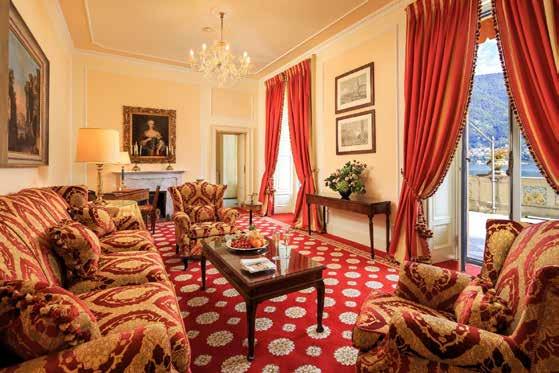
Wine, he says, is to be regarded as “an essential and natural part of human evolution, history and civilisation. Wine was not only a beverage. We find evidence of trading and collecting wine from 4,000 to 5,000 years ago. Wine was connecting people across every continent. It is a very special event. Georgia even started exporting wine around 2,500 years ago.”

Symposium guest Guptal Singh, a lawyer and collector from Delhi, added: “Georgia is certainly leading the way in terms of quality and provenance, and the country has embraced its history as the founders of viticulture. I’ve tasted some superb wines here and I am certainly going to add them to my collection.”
A highlight for many was the DRC tasting, which started with a Vosne-Romanée before moving onto Romanée Saint-Vivant and Romanée-Conti, and ended with a 2003 Montrachet. DRC wines are widely regarded as among the best in the world and owner Aubert de Villaine led guests through the tasting.
The fact that wine greats like de Villaine attend the symposium is thanks to passionate French oenophile François Mauss, who devised the event and starts it every year by rather incongruously shouting “Yabba Dabba Doo!”
“I am simply a great fan of the Flintstone family,” he told me. “I did this the first year and it has become a tradition.”
Among the guests was Justin Bonner, who runs a beer brewing company and was at the event for the first time. “I am a devotee of DRC and I also wanted to experience visiting Italy. The wine symposium offered me the opportunity to meet wine lovers from around the world and people that I likely wouldn’t come across in my everyday life.
“The DRC tasting was one of the highlights, as was the opportunity to experience new wines from less heralded wine regions. Great wine is most appreciated in great company
and the environment must be welcoming and unpretentious – and without barriers.”
Villa d’Este certainly works hard to be welcoming and the longserving staff are warm and attentive, with plenty of personality, wit and charm.
The hotel and setting are breathtakingly romantic. Designed by the famous 16th-century architect Pellegrino Pellegrini, the villa was built as the Cardinal of Como’s summer palace and is considered to be among the most beautiful architectural works of its time. It is surrounded by a private park with centennial plants, and guests can admire works of art including Pellegrini’s Nympheum, the Hercules Fountain and the Telemachus Statue.

In the early 19th century, the villa was the much-loved home of Caroline of Brunswick, queen consort and estranged wife of George IV, and was opened as a hotel in 1873. Villa d’Este is now one of Italy’s foremost grand hotels and has attracted a glittering list of celebrities, politicians and aristocrats, from Elizabeth Taylor to Frank Sinatra. George and Amal Clooney’s home
isnearby and they often visit for dinner. During her time at the villa, Caroline of Brunswick enhanced both the building and the local town, helping build roads in Cernobbio and establish its reputation as an exclusive destination. She was also known to have been fond of fine wines and, no doubt, would have thoroughly approved of the villa hosting such a celebrated symposium.
The Villa d’Este Wine Symposium offers an exclusive insight into the past, present and future of the noble grape and it is fascinating to see how wine continues to connect people across countries, cultures and centuries – sometimes joining the unlikeliest of dots. Even Yasmin the yak, with her contribution to the outstanding Ao Yun wine, shares an affinity for atmospheric landscapes with Caroline of Brunswick herself, who wrote in her diary that “Villa d’Este’s garden seems almost suspended in the air and forms a scene of complete enchantment.” From the world-class wines on offer to the exquisite setting, the Villa d’Este Wine Symposium will also leave oenophiles on cloud nine.
VILLADESTE.COM


Designs on the
Inside
Caribbean Queen Culture, history and warms seas beckon in Canouandubbed the new Mustique Vive le livre Tour France with a literary lens
 Dorsett
the West London hotel, perfect for a luxury staycation
Dorsett
the West London hotel, perfect for a luxury staycation

It's a crisp autumn evening in the bustling heart of Shepherds Bush. Leaves are gently tumbling, setting the stage for a memorable night at a classical concert I had been lucky enough to be invited to.

And while I am a Londoner, our apartment was an hour’s cab ride away – and, after all, what’s more decadent than getting a hotel for a weekend in your own hometown?
I chose carefully but, as it turns out, also wisely. The Dorsett Hotel is a sanctuary that seamlessly weaves together history, design, and pure indulgence.
As I stepped through the doors, it was impossible to ignore the sheer elegance that enveloped me. The hotel's exterior, draped in the timeless facade of the Shepherd's Bush Pavilion, hinted at a rich history. But as I ventured inside, a captivating fusion of old-world charm and modern sophistication greeted me.

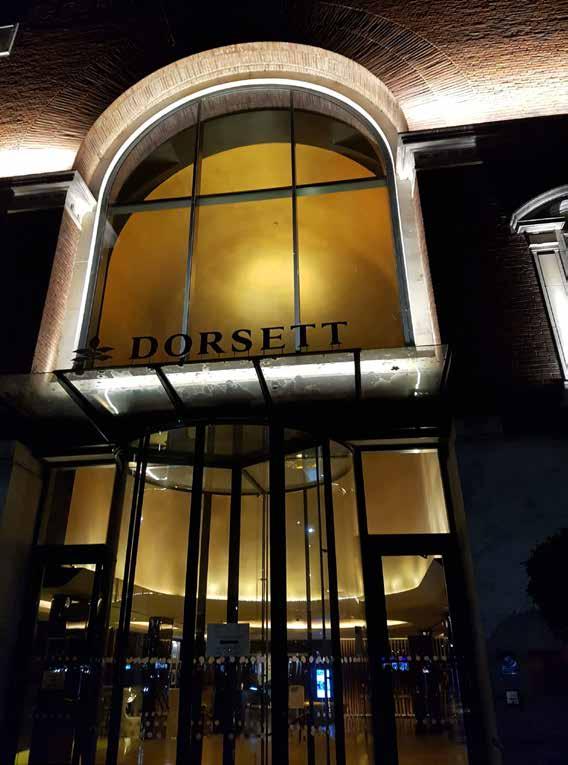
The lobby, an enchanting blend of black and gold, instantly transported me to the glamorous Shanghai style of the 1930s. Velvet armchairs
beckoned, and the walls adorned with portraits of Hollywood icons like Audrey Hepburn added a touch of allure.
My suite, a true sanctuary, was an embodiment of luxury. Floor-to-ceiling windows framed an urban panorama that was nothing short of mesmerizing. The attention to detail, from the plush bedding to the opulent toiletries, left me in no doubt that this was a haven of comfort.
In an industry that thrives on lavishness, it is often the exceptional staff that truly elevates an experience from luxurious to unforgettable, and this hotel's staff unquestionably accomplished just that.
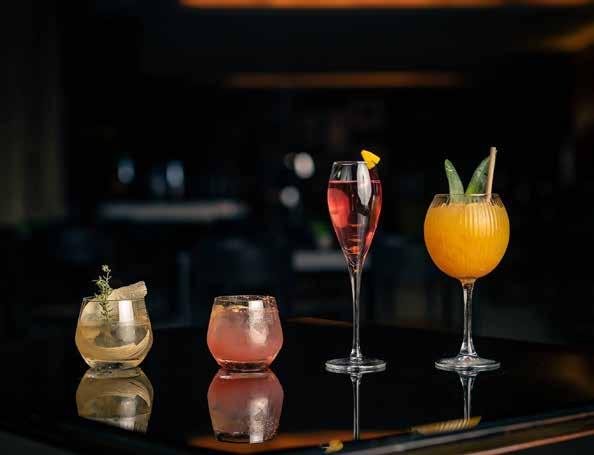


The reception and concierge teams were exemplary in their professionalism and attentiveness. They greeted us with warm smiles and a genuine willingness to cater to our every need. It was clear that nothing was too much trouble for them, as they seamlessly arranged transportation to and from the concert. Later, when my wife encountered an unexpected drama with a shoe, a member of the staff secured a nearby cobbler to repair the damaged heel - and delivered it back to our room within 20 minutes – meaning we didn’t miss the start of the concert.
Dining at the Dorsett was a culinary journey that I won't soon forget. Shikumen, the Chinese restaurant, offered a delectable menu that featured everything from Xiao Long Bao to stir-fried scallops with asparagus in XO sauce.
a captivating fusion of old-world charm and modern sophistication



After two nights of luxury and music, I indulged in the hotel's spa—a serene refuge complete with a sauna, steam room, and an enticing menu of treatments, including a strawberries and cream body polish for my wife who declared the pampering rejuvenating for both body and soul.
Dorsett Shepherds Bush is a living testament to the harmonious fusion of British charm and Asian hospitality. The Chinese-inspired decor, the captivating Asian cuisine, and the seamless blend
of cultures create an ambiance that's warm and enchanting.
Beyond the hotel's walls lies a world waiting to be explored. It's just moments away from the colossal Westfield London shopping centre of course —a paradise for shopaholics like me. I will certainly return Dorsett Hotel in Shepherds Bush. It isn't merely a place to rest your head; it's an experience, an exquisite symphony of style, luxury, and design.
Dorsett Hotel 58 Shepherds Bush Green London W12 8QE

an exquisite symphony of style, luxury, and design
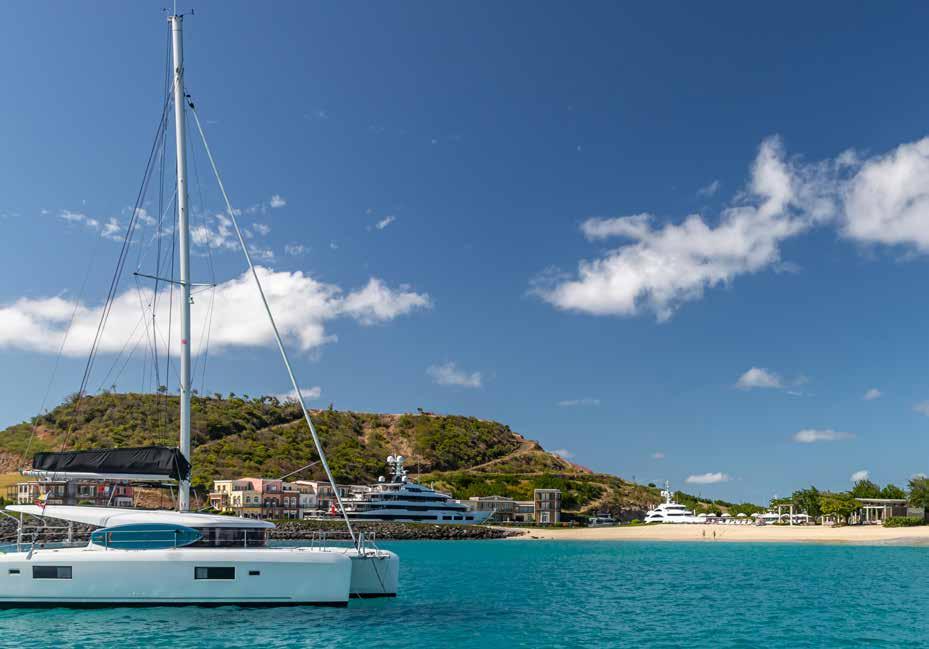 By Dawn Alford
By Dawn Alford
Tt’s the island paradise said to be where billionaires go to escape those pesky millionaires. In truth the island is exclusive and luxurious - but is also hugely welcoming and worth saving up for.
Those specialising in elite holidays believe that this haven has effortlessly bypassed the likes of Mustique and St Barts. My stay at Canouan’s Mandarin Oriental convinced me this is true.
In a ruthlessly competitive race to provide otherworldly travel experiences, the brains behind this hotel are winning.
Canouan is in the heart of St. Vincent & The Grenadines, an archipelago made up of 32 islands including St. Vincent, Mustique, Petit St. Vincent, Bequia and Palm Island. Known as the island of tortoises – you see them everywhere – it is five beautiful miles of lush, tropical, rolling hills that peak at the top of Mount Royal.
Home to the Caribbean’s largest natural coral barrier reef, it is also known for its exceptional white-sand beaches. The word unspoiled hardly covers Godahl Beach, Carenage Bay, Shell Beach, L’Ance Guyac and Grand Bay. Fine white powdery sand, clear azure sea and a seemingly always cloudfree sky are picture-book perfect.
But there is so much more to Canouan. For a relatively small island, it has a surprising number of top-notch amenities which attract the very wealthy.
These include a super-yacht marina, championship golf course and an airport runway that can accommodate aircraft up to the size of a Boeing 737 or an Airbus A319. Just a few reasons why the island has overtaken competitors. It simply offers more.
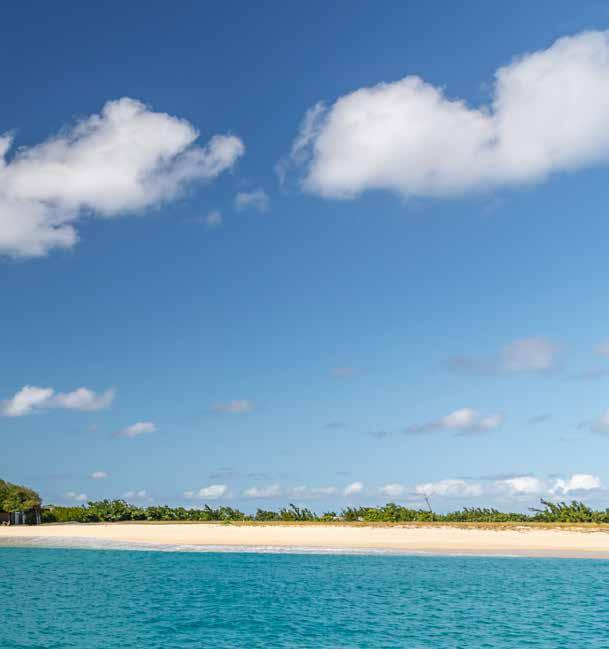
To reach this nirvana, there are main gateways via Grenadine Air’s scheduled flights from Barbados, St. Lucia, St. Vincent and Grenada. Private charter planes and Canouan’s private planes are popular options for getting to the island. We took the hotel’s private jet from Barbados and heartily wished the 20-minute journey had been longer. It’s a fact that travelling this way thoroughly spoils you; those ordinary flights taken by most of us really cannot compare. The views of the island as we came in to land took our breath away.
The Mandarin sits on the 1,200-acre Grenadine Estate, a complex that developer is transforming into the next “it” destination in the Caribbean. The lure is a world of luxury where every single detail is spot on and all tastes catered for.

Unlike those more well-known destinations, Canouan is remote and the beach is inside a gated community, which makes it, according to Duarte Correia, the Mandarin Oriental’s general manager, an ideal place for celebrities and high-profile people who don’t want to see or be seen.

“We are super, super private,” he says. So private, in fact, that Hollywood A-listers have passed through with never a mention, although Amy Schumer did post about her babymoon to Canouan.
All the buzz and the new developments have sparked the question: is Canouan the next St Barths, Antigua or Turks & Caicos? But Correia has the right answer: “Ideally the island will not be the next anything, but instead become its own thing”.
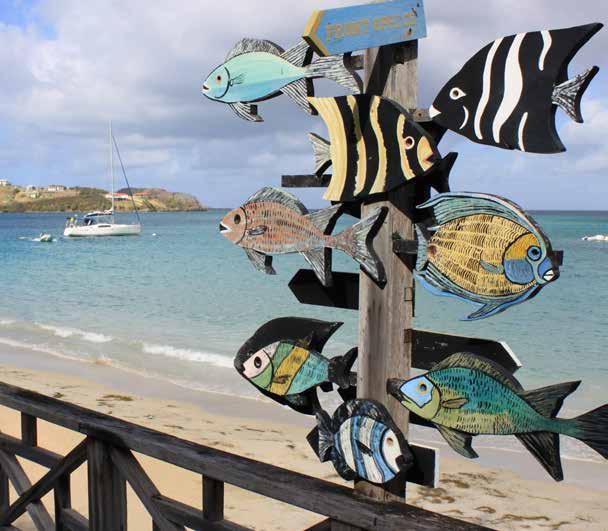
Joan Roca, CEO and founder of the Essentialist travel site, says: “There’s been a lot of talk recently about Canouan, particularly among sophisticated clientele looking for a balanced share of luxury and adventure.
“In the next few years, we expect this underthe-radar hotspot to emerge as the perfect luxury Caribbean micro-island.”
At the Mandarin, the brand’s first property in the Caribbean, there are 13 villas with 12 more in the works, and 26 sumptuous colonial-style suites, all with hypnotic views of Godahl Beach and the Atlantic Ocean.
All 26 of the one- and two-bedroom suites are furnished, as you might imagine, to the highest standard. The smallest rooms are 1,200 sq ft, complete with a living room that closes off from the bedroom, and decked in white Italian marble.
The rooms are easily some of the nicest in the entire region, with spacious en suite bathrooms with separate baths and showers, walk-in closets, full honour bar and Nespresso coffee and tea makers. Touch-screen tablets put guests in control of every aspect of their room including room temperature, lighting and entertainment. I stayed in a beachfront one-bedroom suite which had a private garden leading to the beach just steps away. Each suite
has a butler who checked in with us regularly on WhatsApp.
The first floor Oceanview one-bedroom suites feature expansive, fully-furnished, seaview balconies and there are four two-bedroom Oceanview suites with spacious balconies or terraces showcasing beach views. Two one-bedroom Oceanview penthouse suites are designed to feel like private residences. On the first floor, these open to a grand foyer leading to a large living room area, ocean-facing bedroom, a dining room with a wine tower, and an adjoining designer kitchenette. Both Oceanview penthouse suites have spacious, breezy terraces for lounging and ocean gazing.
Always looking to further enrich the experience, the owners have added the Patio Villas. Designed by a team of Italian architects, these meld beautifully with the tropical landscape.
Combining airy enclosed spaces with grand open-air and outdoor living areas, each villa has a dramatic high ceiling entry opening into a stunning living room/dining room space showcasing sea views. All have a kitchen and chef’s pantry plus a garden which features the native tree which each villa is named after. As an added plus, the grand private patio has an infinity pool and Jacuzzi.
The six three-story Lagoon Villas are four-bedroom colonial-style residences on the hillside with panoramic views of Godahl Beach and the island’s impressive coral reef.
Every last detail is covered, including a fullservice kitchen, laundry and golf carts. Looking to substantially raise the culinary bar for the Caribbean, the resort has six restaurants and bars offering the freshest produce in atmospheric beachfront locations.
Just in case we needed more choice, a short golf cart drive away are four additional restaurant and bar options that are also part of Grenadines Estate. We loved Asianne, one of two fine dining restaurants which serves the most decadent breakfasts. And dinner there is a real experience. We watched chefs prepare our steamed Mahimahi, which was to die for.
Tides Bar and Grill is another sophisticated space, overlooking the lagoon, and for a night cap it was hard to beat a delicious cocktail in Turtles bar.
The resort’s unique Castaway dining experience offers guests the opportunity to dine in a remote, idyllic island location for a few hours or an entire today. Whether it’s a sunrise-by-the-sea breakfast, a beachside Bento, BBQ picnic, or a champagneatsunset gourmet dinner.
We knew that in order to match the rest of the complex, the spa would have to be something special. It was. The hillside treatment suites are approached by a wooden walkway which had a calming effect before we even stepped inside. As well as the signature Mandarin Oriental treatments, there is a menu of Essence of Canouan treatments including the Blissful Sea experience and the Emerald Enchantment wellness ritual.
Specialty treatments designed with specific needs in mind include the Golfers Tonic massage and a Digital Wellness Escape.
There is also a Mindful Teen Spa Menu
offering teen-friendly treatments such as the Texters Treat massage and Little Mermaid Manicure & Pedicure. The first-rate fitness centre caters to anyone wishing to burn off the calories of all those delicious meals.
The resort’s famous golf course would also help with that. Canouan has the only championship 18-holer in St Vincent and the Grenadines. The legendary golf course designer Jim Fazio is to thank for this, which is as challenging as it is beautiful.

The island itself has an interesting history. Donald Trump’s casino, which went bust years ago, is still standing. We took a spooky tour of the abandoned building which has a definite Marie Celeste vibe, with ivy growing inside the rooms, and an old piano which had once seen heady, highrolling days. The contrast between the ruined casino and the pristine Mandarin Oriental could hardly be more marked.
As you do, in the Grenadines, we took a yacht to the mustvisit destination of Tobago Cays. This was where Pirates of the Caribbean was filmed. We dawdled along the deserted beach in the famous scene in At World’s End, where Jack Sparrow drunkenly hallucinates and finds various versions of himself.
Tobago Cays comprises five small uninhabited islands and a protected coral reef with no fishing allowed, offering some of the world’s best snorkelling. In fact if you stayed a month you could not cover all the stunning dive sites.
Anyone seeking a Christmas/New Year holiday with a difference could consider Canouan. Festive season highlights at the Mandarin include participating in release of turtles to the wild. It is one of many celebratory occasions from 19 December to 5 January and a glamorous gala dinner is held on New Year’s Eve.
All in all, this little island packs a huge punch. Will it delight the senses of a jaded billionaire? Well if anything can, Canouan can.

Mandarin Oriental, Canouan offers rooms from $1,550 based on two people sharing on a B&B basis with butler service. Price also includes welcome airport concierge in Barbados, transfers in Canouan, twice daily housekeeping, beach of the day programme, a onetime complimentary access to all beers, non-alcoholic beverages and snacks in the minibar, all non-motorized watersports including sailing, windsurfing etc. tennis facilities and kids club.
MANDARINORIENTAL.COM
As you do, in the Grenadines, we took a yacht to the mustvisit destination of Tobago Cays where Pirates of the Caribbean was filmed.
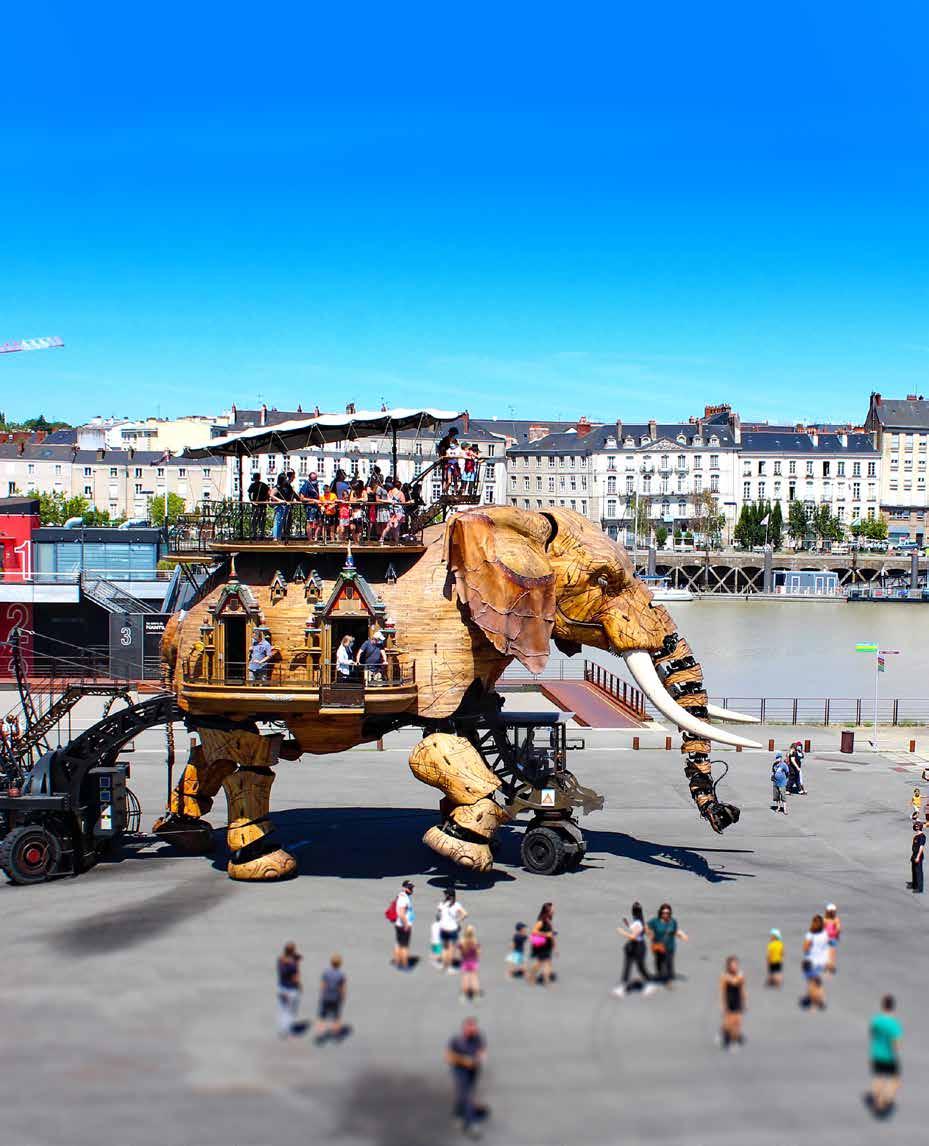

 By Rob Crossan
By Rob Crossan
We need not congratulate the French any further on their abilities to make winningly bad pop music, always look good in Breton striped shirts and retire at the age of 52. Far less heralded is how the best French authors have managed to imbue their places of origin into their greatest works in ways that just beg for further exploration. Whether your urge, after reading Madame Bovary, is to seek out the provinces of France that Emma dreamed of fleeing from or whether you desire a night in the bawdy bars depicted by Balzac after reading A Harlot High And Low, here are five of the greatest French literary home towns.
The father of science fiction would, one would assume, not be too surprised were he to return to Nantes today to see a giant mechanical elephant parading around an industrial wasteland. That is exactly how Jules Verne’s legacy has manifested in the form of ‘The Machines Of The Island Of Nantes’. Located in the middle of the Loire river the 39 foot high elephant (which you can take a ride on top of as it moves around the island) has recently been joined by an immense carousel which visitors can move about amidst a ballet of aquatic animals. Stay the night in Le Plateau Jules Verne, a collection of Verne themed suites. The De la Terre à la Lune (From the Earth to the Moon) is a delight with a spaceship style sleeping bunks for kids and a stone cellar lined with cabinets filled with ephemera inspired by his books.
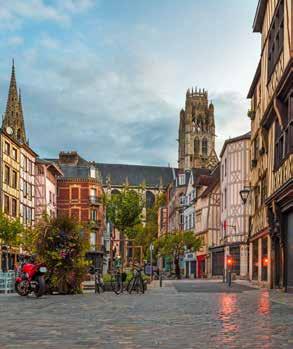
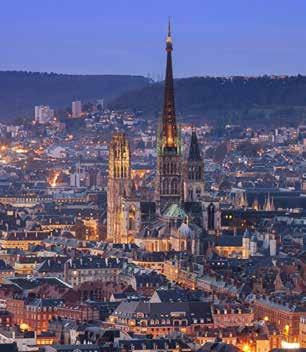
Half-timbered houses lining the banks of the Seine, a towering Gothic church and bijou brasseries; the hometown of Gastav Flaubert plays a starring role in Madame Bovary where bored Emma meets Leon the lawyer inside the cathedral before embarking on a very carnal cab ride around the town and surrounding countryside, a passage which put Flaubert himself in the dock for an obscenity trial which he won. Heavily damaged during World War II, the town today is home to the Museum of Flaubert, a gallery where you can see images of the hospital where his surgeon father worked and the room in which Gustav was born. More evocative is the Flaubert Pavilion in the small town of Canteleu, about 15 minutes’ drive outside the town. This is the only part of the house where Flaubert worked and lived for around 15 years that is still standing, and it’s full of miscellaneous writing equipment, engravings and drawings that all belonged to the great chronicler of petit bourgeoisie frustrations.
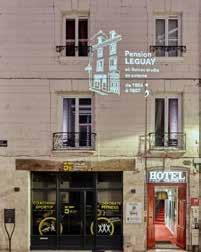
The largest city in the Centre-Val de Loire region was strangely modest about its status as the birthplace of one of the founders of the 18th century realist movement in literature until very recently. Balzac’s novels may be full with the noise of rowdy Parisian hotel bars and raconteurs bickering in cafes but the man himself was raised in a typically bourgeoisie household with distant parents who packed him off to live with a wet-nurse as an infant for four years. Despite this far from loving upbringing Tours was a town he returned to again and again, describing it once as “amorous, buxom, blooming”; the town, and its Gothic Cathedral Saint-Gatien, the Abbaye de Marmoutier, and the grandiose Pont Wilson bridge are mentioned in more than 40 of his works. The most atmospheric spot of all is the Hotel du Theatre. Located opposite the opera house this is the intimate spot (called Pension Le Guay in Balzac’s time) where young Honore learned to read and write between the ages of five and eight. The hotel today has a dedicated Balzac nook where you can sip coffee (Balzac drank up to 50 cups a day) and get cracking on Le Comedie humaine.


“My house remains for me what it always was, a relic, a burrow, a citadel, the museum of my youth”, wrote the grande dame of French letters back in 1907. Colette’s famously acute vanity and high self-regard suggests she would be delighted by the meticulous retro-fitting of her childhood home in Saint-Sauveur-en-Puisaye, 100 miles from Paris, into how it would have looked during her time there. Away from the salon style furnishings of the house (think pianos, oil lamps and acres of terracotta and marble) the village, in the departement of Burgundy, L’Yonne, is also home to the Musee Colette. Housed in an ancient chateau and opened by her only child Colette de Jouvenel in the 1990’s, the rooms are full to the brim with photos of Colette and her family. Around 100km east in the pretty town of Saulieu Colette’s favourite restaurant is still in business. Called L’Hostellerie de la Côte in her time, the name may have changed to Relais Bernard Loiseau but the lusty Burgundian dishes of frogs legs and hazelnut liqueur soufflé are as rich and robust as she would have remembered.

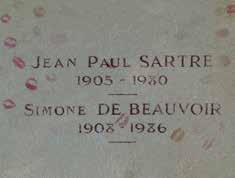
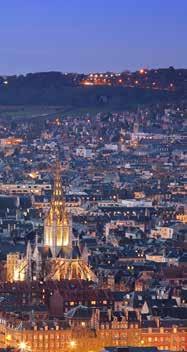
There may not be quite so many Gauloises smokers and there are definitely fewer black polo necks on display but the outdoor tables at Café de Flore on the Parisian Left Bank still exude a bohemian air. This is where Jean Paul Sartre, along with his partner Simone de Beauvoir and a motley crew of the city’s intellectual elite would discuss essence, existence and (possibly) the larcenous price of a café au lait in this defiantly unchanging café- still with the Formica and nicotine stained wood interiors that the existentialist thinkers would have known. From here it’s a five minute walk to place Saint-Sulpice, home to Cafe de la Mairie. This was where Sartre and Albert Camus would regularly meet during their tenures working on the radical left-wing newspaper Combat. It’s also known as the last place they met, a fierce argument in 1951 resulted in the two of them never speaking again. Over in Montparnasse Cemetery lies Sartre’s final resting place. Despite numerous infidelities and fallings out, Sartre and de Beauvoir were buried together (Simone died in 1986, six year after Sartre). You can find their modest grave by picking up a free map from the warden’s hut. The faded sandstone grave does usually have some brash licks of colour on it; lipstick marks from those who kiss the headstone. Hell is other people indeed.
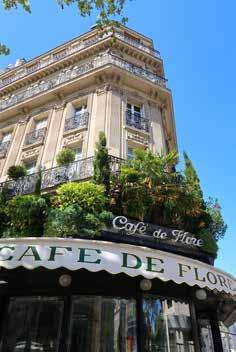


WATCHES OF SWITZERLAND 439 OXFORD STREET











LONDON W1C 2PN


























































